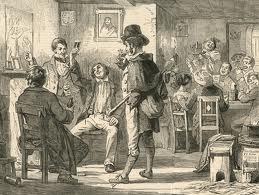Arlene Stafford-Wilson's Blog, page 33
March 25, 2022
Bill Buffam, Craftsman

In 1978, an article appeared in “The Perth Courier”, featuring Bill Buffam, and his family, and the beautiful handcrafted pieces he produced. It was said at the time that their home at R.R. # 5, resembled a museum, with some of the pieces dating back to the 1860s.

“In 1965, Bill was hired by the owners of two antique businesses to restore buildings built in the 1820s, and some of the furniture. What started as a hobby, soon became his profession.”
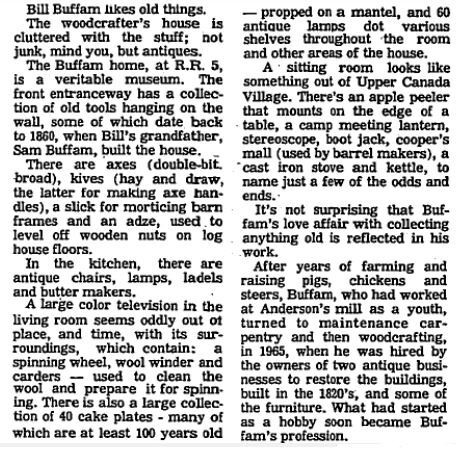
“One of his specialties are custom-made canopy beds. They take a week to build, cost about $500., and are ordered a year in advance.”

“The key to Buffam’s success is the pride he takes in his workmanship: meticulously copying old simple Canadian Furniture.”
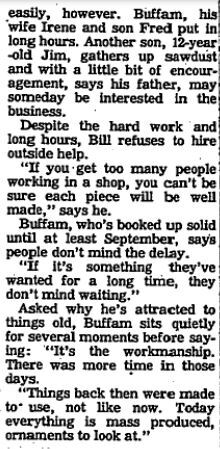
“Things back then were made to use, not like now. Today everything is mass produced, ornaments to look at.”
Article from: August 2, 1978, p. 2, “The Perth Courier”
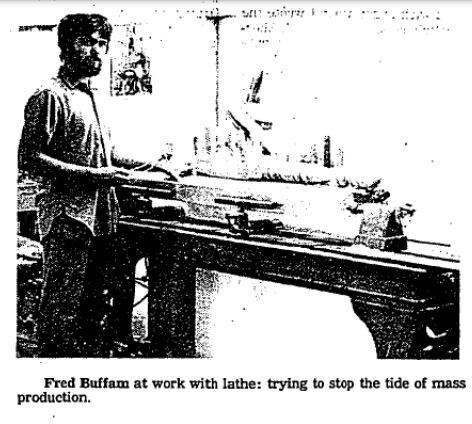

Lanark County has been the home to many artisans and craftsmen over the years, and Bill Buffam, set a fine example by taking a skill, perfecting it, and sharing the finished products with the many who admired and purchased his work through the years.
I wonder how many of his customers still enjoy his fine pieces in their homes today?

Arlene Stafford-Wilson
St. Augustine’s & Heritage Homes, Prospect
Saint Augustine’s Anglican Church is located at Concession 3, Lot 26, 261 Richmond Rd, Prospect, Lanark County, Ontario, Canada
Built in 1854, by stone mason John May, on land donated by William James, with lumber and stone supplied by parishioners, St. Augustine’s has a seating capacity of 120, and the church served a group of early Irish Anglican settlers who had been meeting up to that time in a school house.
In 1888 St Augustine’s became part of the Parish of Ashton. St. Augustine’s Church and cemetery were consecrated by Bishop Charles Hamilton on September 24, 1896.
Closed in 1967, the building, cemetery and grounds are maintained by the Ashton Parish. A service is held once a year in August.

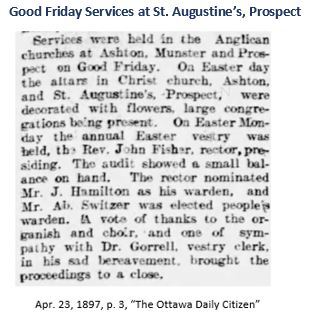
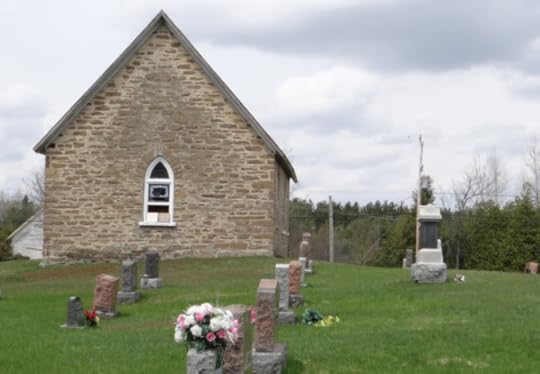
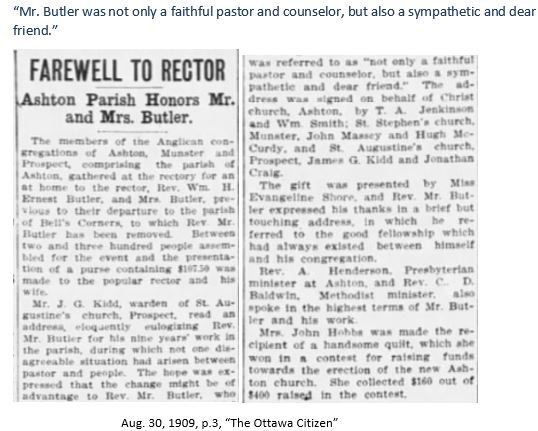
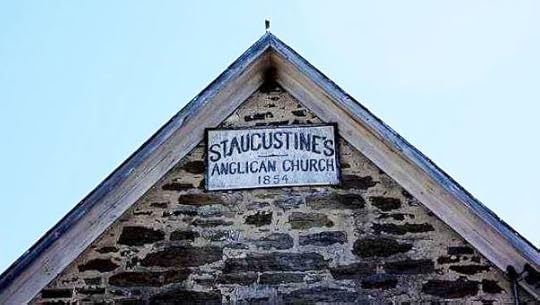
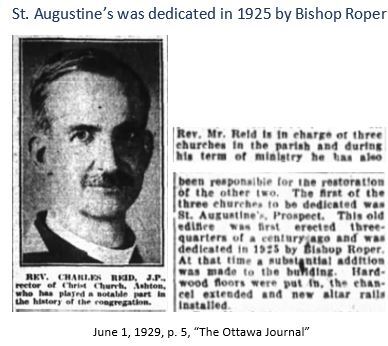
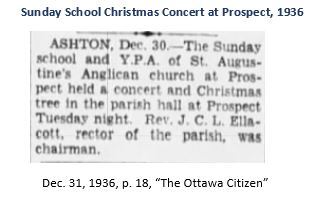


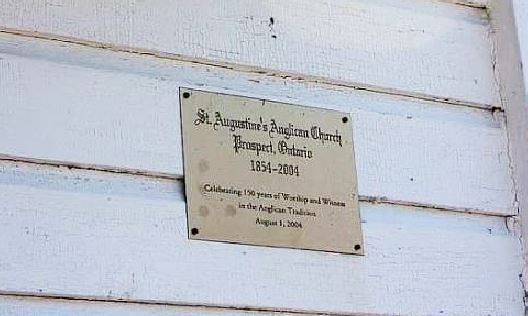
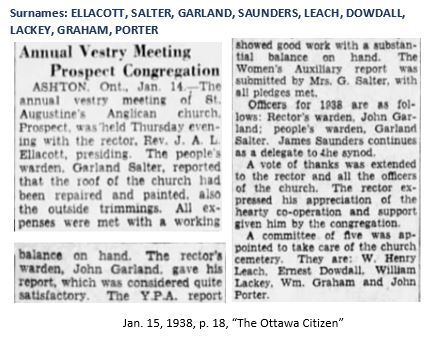

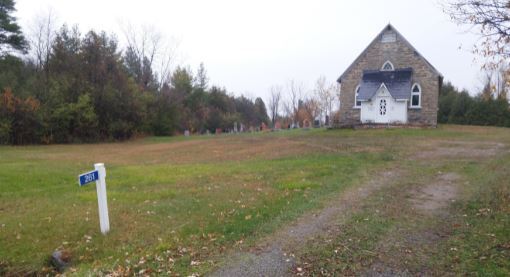
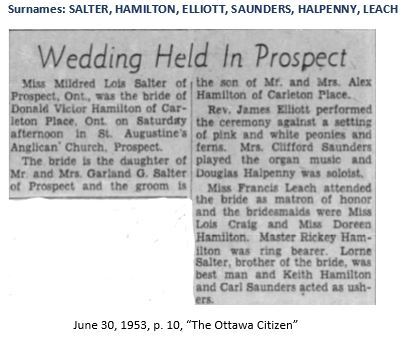

June 24, 1954, p. 12, “The Ottawa Journal”
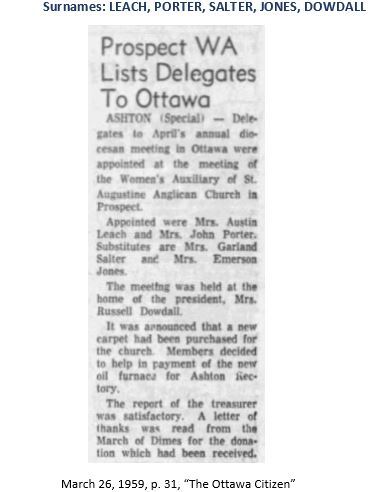
James Family
Heritage Home
This heritage home has changed hands over the years: William James was the original owner. The James family donated the land for St. Augustine’s Church in 1854. John Porter bought the house from a son-in-law of the James family. The home was purchased by Mr. and Mrs. D.B. Rees, who sold it to Arnold and Moira Guetta.
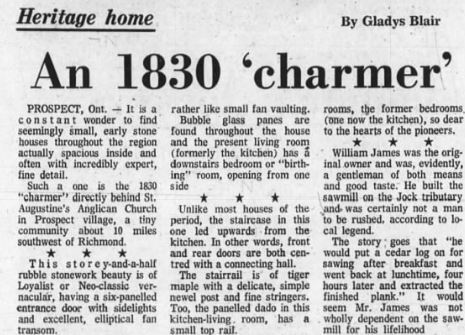
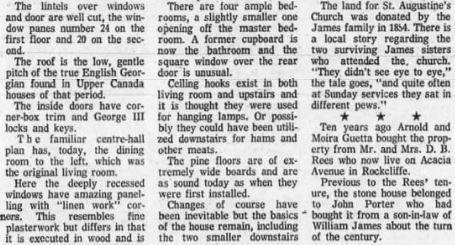
Aug. 19, 1972, p. 31, “The Ottawa Journal”
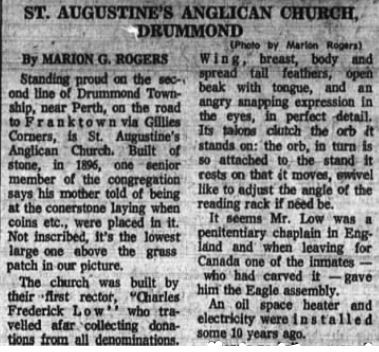
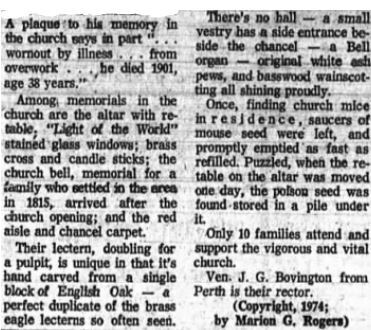
May 4, 1974, p. 42, “The Ottawa Journal”
Prospect Heritage
House Tour 2007
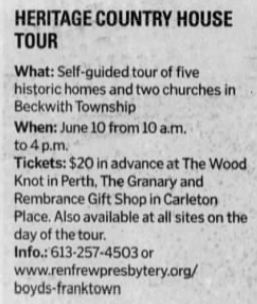
June 2, 2007, p. 88, “The Ottawa Citizen”
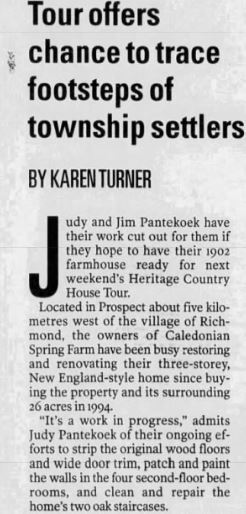
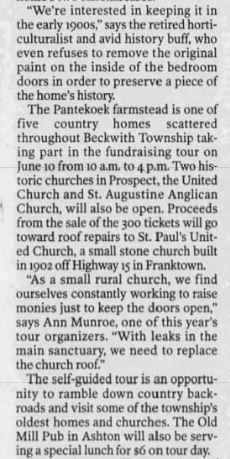
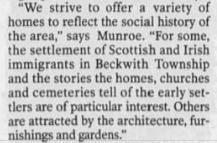
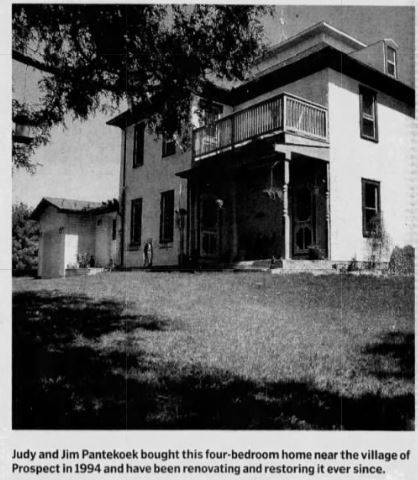

June 2, 2007, p. 88, “The Ottawa Citizen”
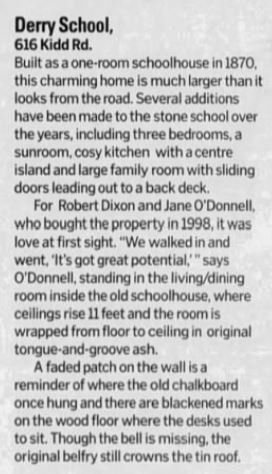
June 2, 2007, p. 88, “The Ottawa Citizen”

June 2, 2007, p. 88, “The Ottawa Citizen”
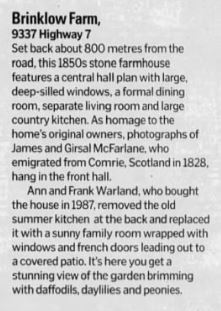
June 2, 2007, p. 88, “The Ottawa Citizen”
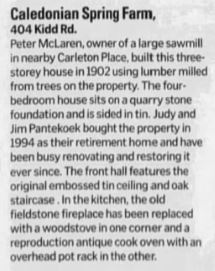
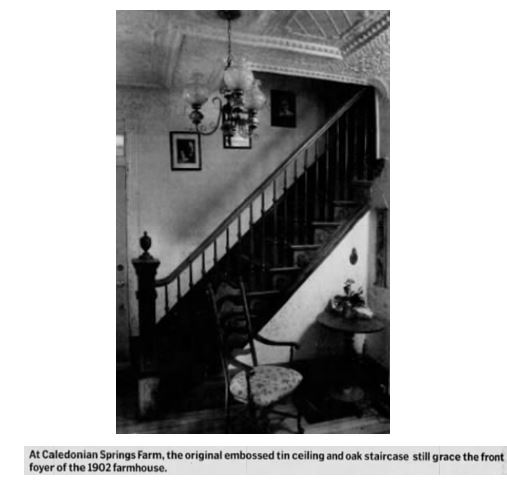
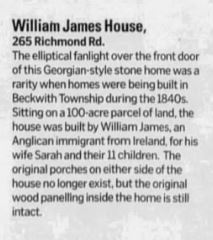
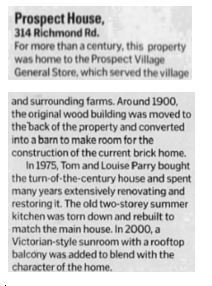
Some of the family names in the area: Bennett, Beveridge, Blair, Boyle, Budd, Carrigan, Cassell, Christie, Craig, Douglas, Dowdall, Featherston, Flinn, Garland, Gladden, Goodenough, Graham, James, Kinsella, Lackey, Leach, Lewis, Makinson, McMullen, Parry, Plant, Plaunt, Porter, Presley, Rathwell, Rothwell, Salter, Saunders, Simpson, Wilson.
Sunday Drive
or Walking Trails
Prospect is surrounded by farmer’s fields, thick forests, and scenic walking trails. One of the nicest trails, Goodwood Marsh Nature Trail begins at the Beckwith Recreation Complex located at 1319 9th Line Beckwith, linking to the Beckwith trail network

Arlene Stafford-Wilson
Balderson Cheese – Craving the Curd
Whenever a kid in Lanark County heard the word ‘Balderson’ spoken at their home, most of the time their thoughts turned to cheese. The Balderson Cheese Factory was a short drive up the Lanark Road from our place, and they made the best cheese in the world. People came from miles around to buy Balderson Cheese, curds, and butter, and our family was no different. Usually a visit to the cheese factory took place as part of a Sunday drive.
Balderson was a small hamlet situated about halfway between Perth and Lanark and was one of the earliest communities settled along with Perth. Balderson, a suburb was also settled partly by soldiers, and partly by Scottish immigrants from Perthshire in the Scottish Highlands. It was founded by Sergeant Balderson in June 1816.
When we spent time in Balderson during the 1960s and 1970s some of the family names were: Bell, Burns, Davidson, Devlin, Haley, Jones, Kennedy, King, McGregor, McIntyre, McTavish, Myers and Newman.
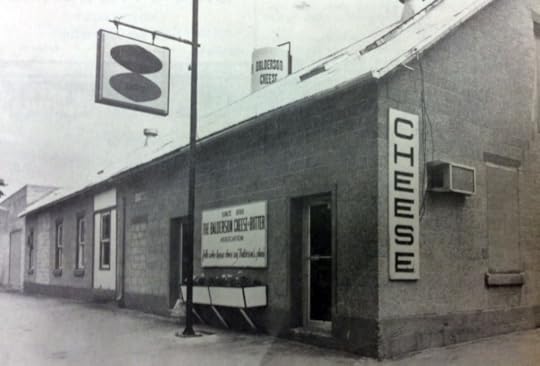
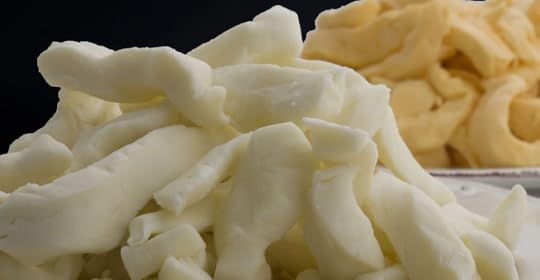
The Balderson Cheese Factory had already been operating for many decades by the time I first remember it. The factory was established 1881. It was formed by a group of dairy farmers of Lanark County. They were known as the Farmer’s Cheese and Butter Association of Balderson. They decided to use the excess milk that they were each producing on their farms, build a factory, produce Cheddar cheese and sell it locally. They built a small, plain-looking, wood-frame building near the Balderson Corners crossroads.
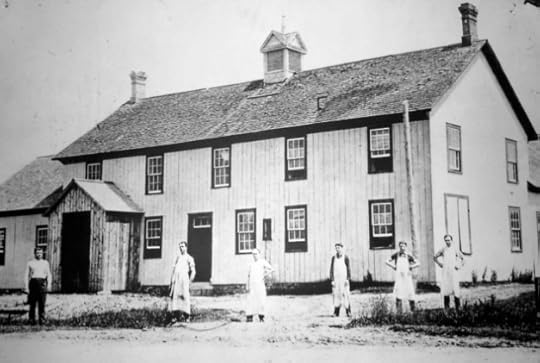
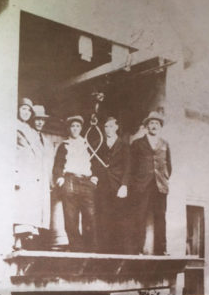
In the early days, each dairy farmer would bring their milk by horse and wagon and drop it off at the factory. Later, to become more efficient, special milk wagons were built and routes were established and workers from the factory would go from farm to farm picking up the milk.
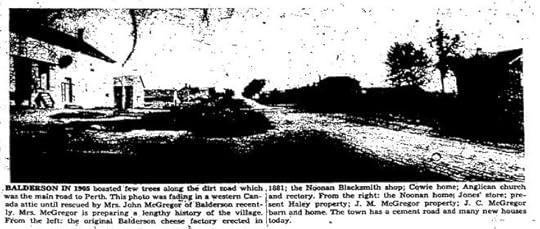
Just twelve years after opening, the Balderson Cheese Factory was one of the twelve factories that contributed cheese to create the ‘Mammoth’ cheese for the Chicago World’s Fair in 1893. The old timers said that it was six feet high and weighed over 20,000 lbs.
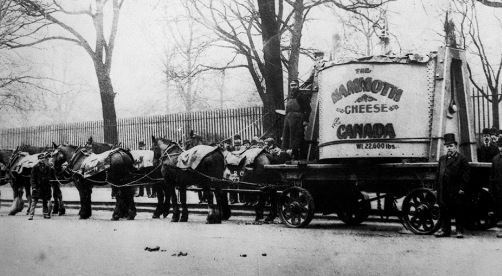
In 1929, a fire burned the original factory and all that was left was the concrete floor.
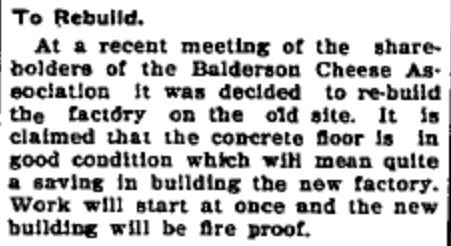
Although Dad was familiar with the original factory, we had only seen the one that was rebuilt in 1930. It was a plain-looking building and was built in a similar style to many of the other local cheese factories, in and around Perth. There was a small sign outside and the inside they had a very small counter and sold three products: cheese – yellow or coloured orange, cheese curds, and butter. You could buy mild cheese or old cheese, and Dad preferred the older ‘sharp’ cheese and liked to enjoy it with a slice of Mother’s homemade apple pie. The cheese was cut from rounds, wrapped in waxed paper and sealed with a piece of scotch tape. There was one person working behind the counter that would get your cheese and ring it up on the cash register. Everyone else worked in the back.
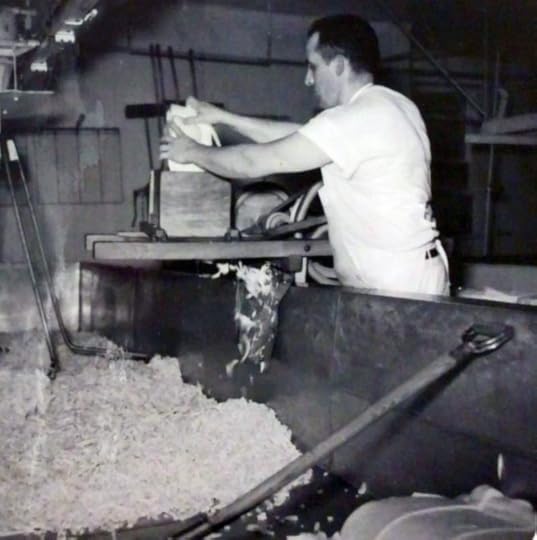
Dad would often know the person working behind the counter, and he’d ask if we could go back and watch them make the cheese. Now, that was really interesting! There was always a distinct smell in the factory, even at the front counter. It smelled kind of like buttermilk, and the air always seemed very warm and humid. It was behind the counter where all the magic took place.
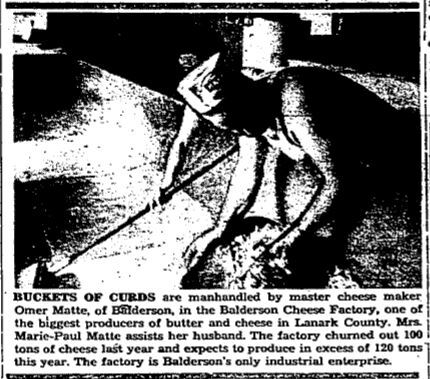
There were huge metal vats, filled with heated milk. I don’t know what they use now, but in those days, they added rennet to the milk to make it curdle. Rennet was an acid which could be found in the fourth stomach of calves and was used for digestion. When the rennet was added to the milk it curdled and formed into clumps. The workers in the factory would walk around with long wooden paddles and stir the vats. Some were newly curdling and were very easy to stir, others in later stages required quite a bit of muscle to stir because the curds were forming in large, heavy clumps. In the last vat the salt was added and some of the curds were strained out and sold, but the remainder would be pressed into huge round wooden molds. The molds were lined with cheesecloth so that the cheese wouldn’t stick when it was time to remove it.
At the rear of the old factory, double walls were built two feet thick, with sawdust packed inside as insulation to keep the cheese cool as it cured. After the cheese was strained and pressed into molds it was stored in the curing room. The whey, the liquid that was strained from the cheese, was stored in big tanks. In the old days the whey was returned to the farmers to use as feed, but later when tighter government regulations were introduced the whey was dumped. Each cheese was waxed, boxed, weighed, molded, inspected, cooled, turned and shipped. The cheese was regularly inspected by Government inspectors and the stock turns over every ten days. The cheese remained in the curing room until it was shipped.
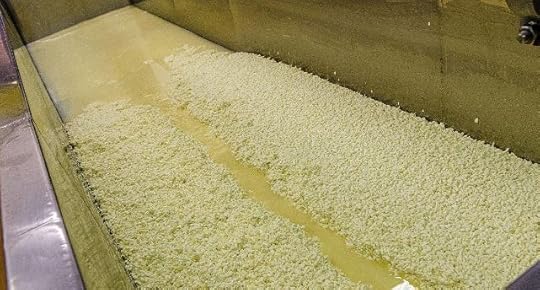
Cheese making was an art form in Balderson and their Master Cheese Maker when I was a kid, was Omar Matte. Mr. Matte had begun making cheese when he was fifteen working for his father in St. Albert. By the 1960s he had been making cheese for 27 years. In those days, Mr. Matte would mold 120 tons of cheese per year and most was shipped to the Sanderson Grading Station in Oxford where it went on to foreign markets. Ten tons of cheese on average was sold locally in the Balderson area. Over 100 tons of cheese and 9,000 pounds of butter produced yearly by the mid 1960s and sold all over North America.
There were many Master Cheese Makers before him – Chris J. Bell of Perth, James Somerville of Boyd’s, Walter Partridge of the Scotch Line, James Prentice of Perth, Charles Gallery of Perth, Robert Lucas of Jasper and Percy George of Christie Lake.
Balderson Cheesemakers1881-1887 W. Brown
1888-1891 J. Milton 1888-1891
1892-1901 W.D. Simes
1902-1904 E.E. Haley
1905-1911 J.M. Scott
1912-1917 T.K. Whyte
1918-1921 M. Haley
1922-1929 A. Quinn
1930 G. Spencer
1931-1937 P. Kirkham
1937-1939 J.L. Prentice
1939-1941 C.J. Bell
1941-1942 J. Somerville
1943 W. Partridge
1944-1955 C. Gallery
1956-1958 R. Lucas
1959-1960 P. George
1961-1966 O. Matte
1966-1974 Y. Leroux
1975-1980 L. Lalonde
1980 N. Matte
As the years passed by, the cheese gained tremendous popularity, news of the product spread, and the little business was bought by a large company. After many decades the Balderson Cheese business has changed hands many times.
You can still find Balderson cheese today, and many types and grades of cheese available in all of the major supermarkets.
I smile whenever I see the Balderson name and think of the little hamlet outside of Perth. I remember our Sunday drives to the old cheese factory, and how they made the best curd in the world!


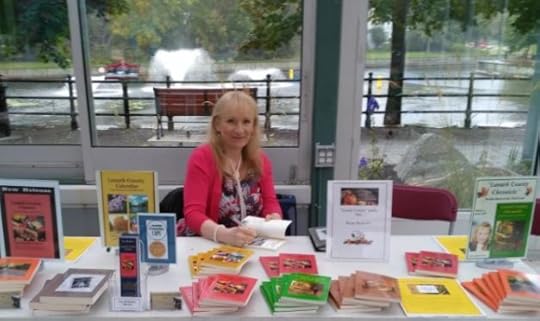
Arlene Stafford-Wilson
(story is an excerpt from ‘Lanark County Kid: My Travels Up and Down the Third Line’ ISBN: 978-0-9877026-16)
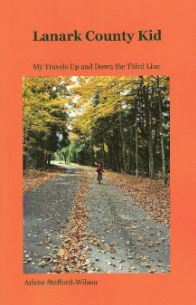
March 24, 2022
Families of Montague Township
Among the first European settlers in Montague Township, Lanark County, Ontario, were United Empire Loyalists, from the U.S., who arrived between 1790 and 1797:
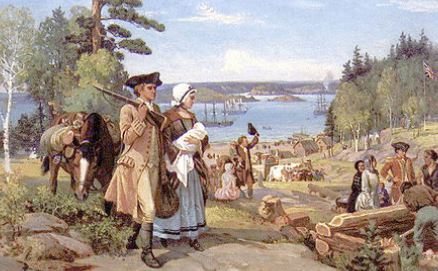
Depiction of United Empire Loyalists – Americans who preferred to remain British Subjects, and who came to Canada after the American Revolution

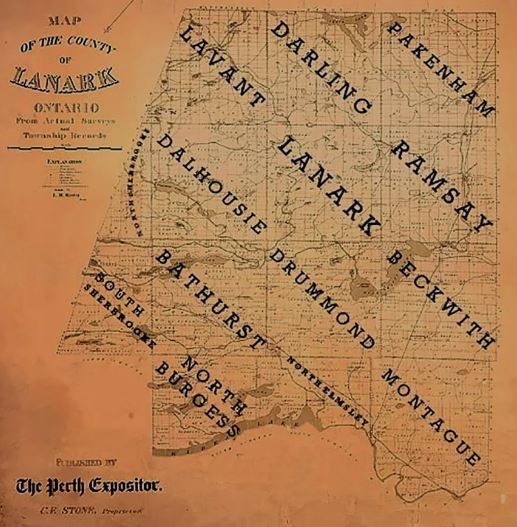
Historic Townships of Lanark County
Montague Township Families listed in 1863:
“The Province of Ontario: a History: 1615-1927”
Acton, Agnee, Anders, Anderson, Andrews, Armrod, Baalf, Bailey, Ballantine, Beamish, Barton, Begg, Bell, Bennett, Billings, Burchell, Bissell, Blair, Blodgett, Box, Bradley, Bramnick, Brennen, Breland, Brown, Buchanan, Buell, Burgess, Burrows, Cadden, Kehoe, Campbell, Carnes, Carnduff, Carter, Cavanagh, Chalmers, Chapman, Chester, Chock, Christie, Clark, Clink, Coad, Cochard, Comrie, Condie, Conich, Conlin, Conlon, Connell, Conner, Copeland, Couch, Crooks, Croon, Croskery, Cusick, Dalena, Davis, Dempsey, Derrick, Devlin, Dillabough, Dizell, Dorman, Dormer, Douglass, Doyle Driscoll, Dumfield, Eamon, Earl, Edmonds, Edwards, Ervin, Everts, Evetts, Farls, Ferguson, Fibs, Finell, Fitzcharles, Fitzgerald, Flannigan, Fleming, Flood, Foley, Foster, Furlong, Giff, Killaly, Gorman, Grace, Graham, Gravelle, Griffith, Hades, Haley, Hall, Hennessy, Hetherington, Hill, Holbrook, Holt, Hood, James, Jones, Kagen, Keating, Kelley, Kennedy, Kerfoot, Kerr, Keys, Kidd, Kilfoyle, Kinchley, King, Knapp, Lake, Lamb, Larkins, Latt, Lave, Lawford, Leach, Leaver, Lee, Leeson, Livingstone, Lewis, Little, Loftus, Long, Loucks, Lowe, Lucker, Lukas, Lumix, Maitland, McClinton, McCance, McCaw, McConnell, McCormack, McCrea, McCreary, McCrutchie, McDermid, McDermott, McDonald, McEwen, McGilvery, McGregor, McInrugh, McLaughlin, McMahon, McMillan, McPhail, McPherson, McQuay, McVean, Meredith, Meroe, Merrick, Millikin, Moffatt, Moir, Moore, Moorhouse, Morris, McIlroy, Murphy, Murray, Nealand, Newman, Nicholson, Nolan, Nullerville, O’Donnell, Payea, Peck, Pendergrass, Pierce, Plant, Poaps, Poole, Prescott, Prichard, Proctor, Publow, Rathwell, Reagan, Rekey, Reid, Richardson, Rickey, Riddle, Robinson, Roe, Rose, Rylance, Saltier, Salter, Sanders, Scott, Shepard, Shields, Shirley, Smith, Splane, Stacey, Stewart, Stuart, Tilman, Taylor, Tiffin, Tilford, Tillebaugh, Tierney, Tomlinson, Tussey, Tripp, Vanderhouse, Vandusen, Wall, Ward, Warren, Watts, Webster, White, Willable, Willis, Wilson, Winne, Wood.
(Jesse E. Middleton, The Province of Ontario: a History: 1615-1927, published 1927.)
Settlements – Montague Twp:
Numogate, Nolans Corners, Rosedale and Kilmarnock (Kilnarne)
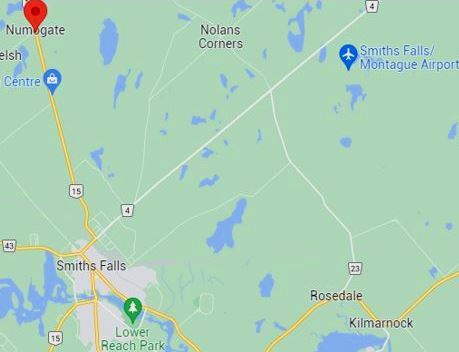
Google maps
Numogate, Montague Township
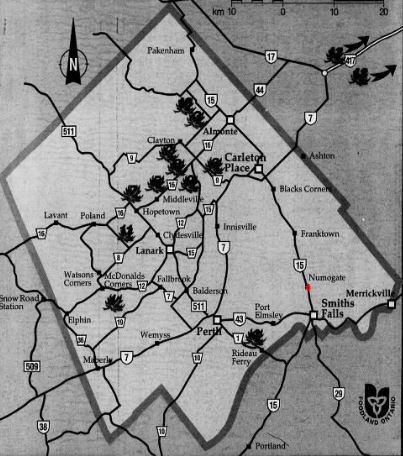 [image error]
[image error]Loyal Orange Lodge 705
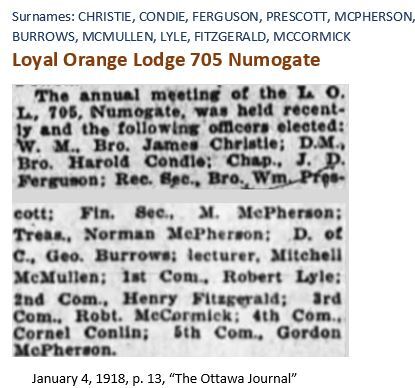
Federal Election of 1925
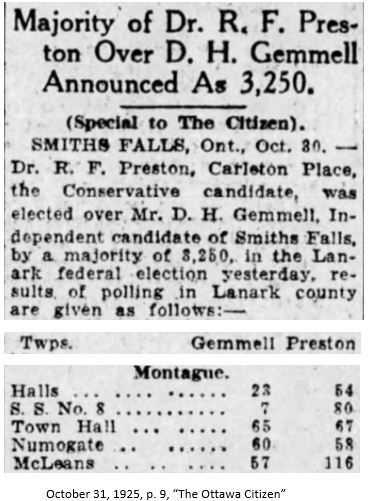
Born in Numogate, Montague
Almonte Police Chief
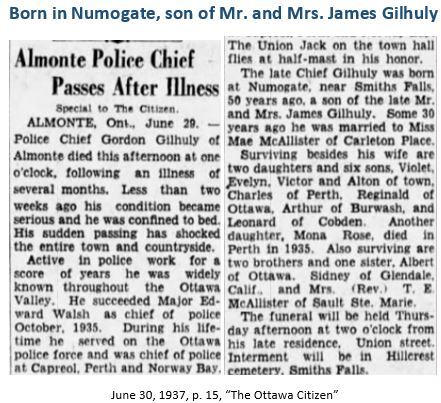
Montague Mailman
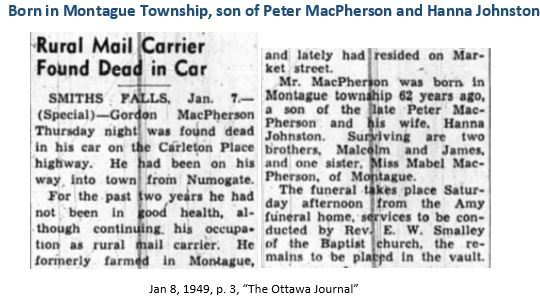
40-Year Old Horse

Cameron Family
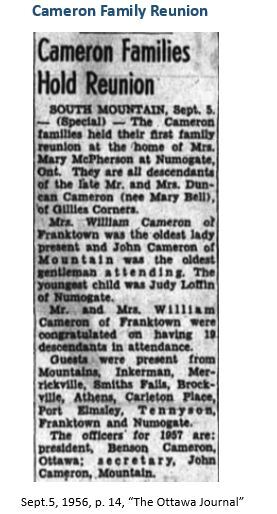
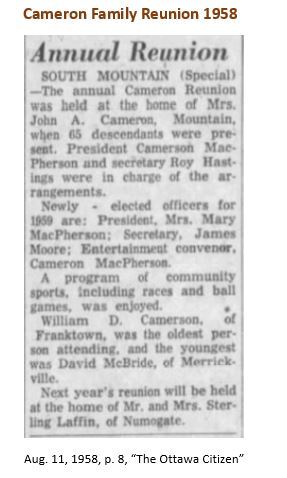
Area’s first Microwave Tower
at Numogate


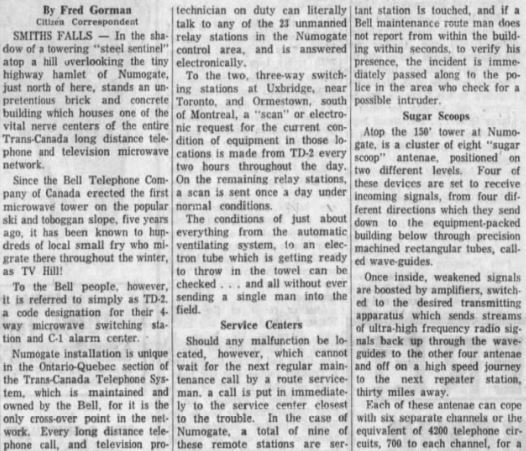
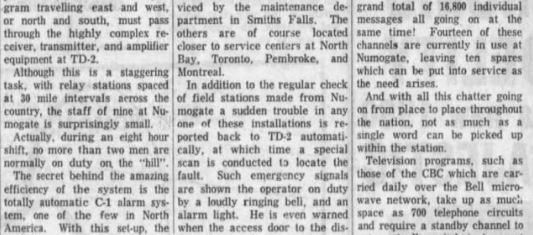


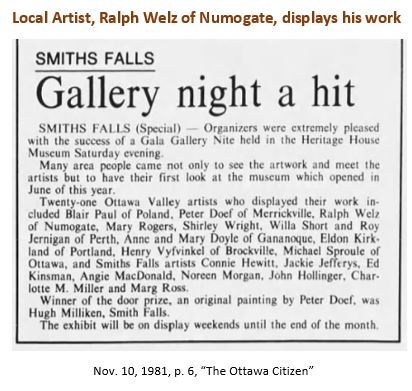
Rideau Canal Byways

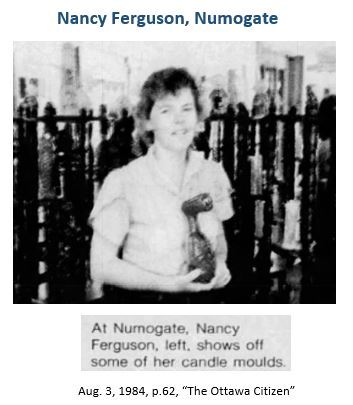
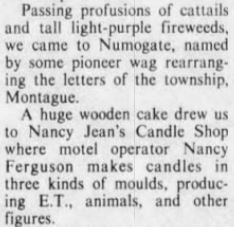

Nolan’s Corners
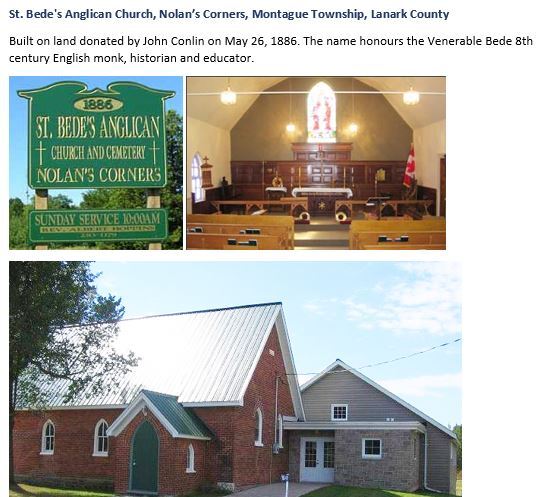
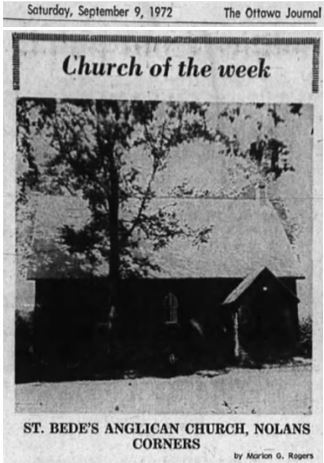
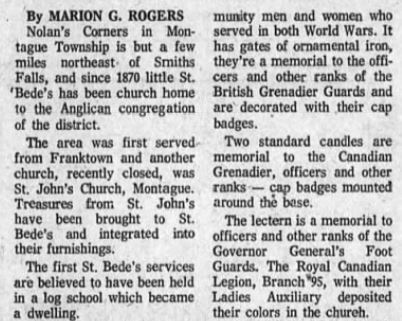
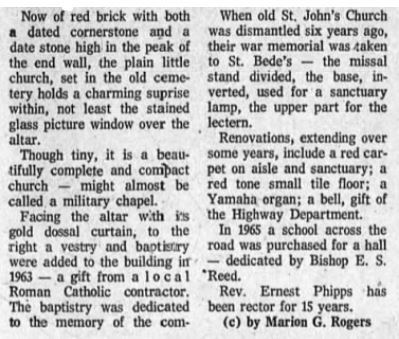
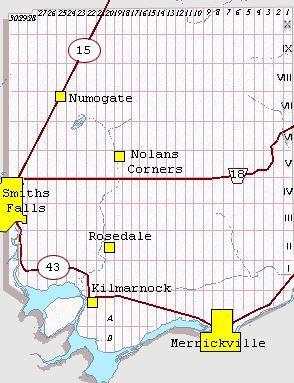
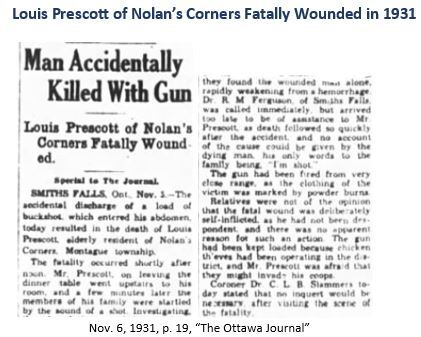 [image error]
[image error]Rosedale Hall

Rosedale Hall, 657 Rosedale Road South
Rosedale Hall
In 2019 The Township of Montague received a grant of $127,500 from the Ontario Trillium Foundation and in 2020 completed the upgrades to Rosedale Hall. Structural upgrades were completed including replacing the floor joists, installing new flooring, a new well was dug, and a new children’s playground and walkway. The hall can be rented for weddings, celebrations of life, or other functions, by the hour or by the day, for residents or non-residents.
Some of the families of Rosedale: Rosedale: Acton, Andrews, Blair, Bunting, Chalmers, Clark, Comrie, Dais, Davies, Davis, Dizell, Flagg, Graham, King, Livingston, Louks, McCreary, McCreery, Lumsden, McEwen, McPhail, McLain, Shields, Moir, Porter, Scott, Smith, Tassie, Vandusen, Wilson, Wall, Watt
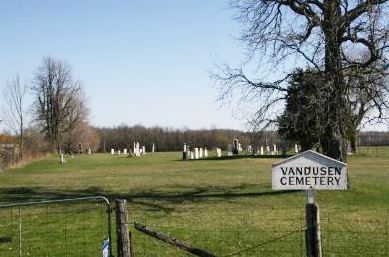
Kilmarnock
Kilmarnock Lockmaster’s House
The Lockmaster’s house was built at the Kilmarnock Lockstation in 1841 by the
Royal Engineers as part of the defence structures for the Rideau Canal. A second storey was added to the main structure in the 1890s, and later a single storey frame summer kitchen. It is a designated historic site on the Rideau Canal system.
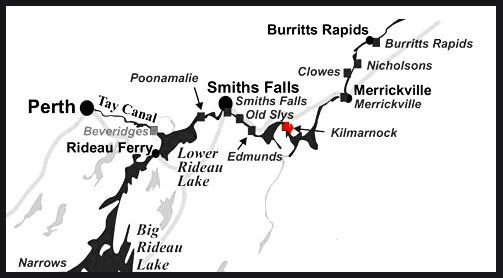
Kilmarnock was originally known as Maitland’s Rapids (named for the first settler, James Maitland), and the locks have what is called an “unequal arm”, with a timber swing bridge. It is the lowest lift of any lock on the Rideau, only 2.2 feet. Not far up the road, is the Kilmarnock Apple Orchard.
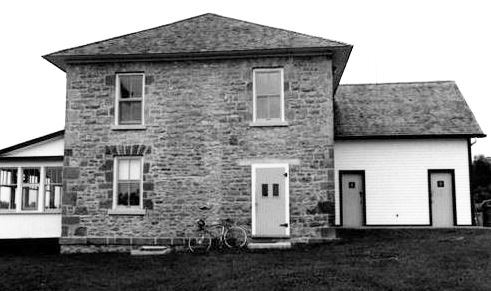
Side of the Lockmaster’s House – photo: Dept. of Public Works
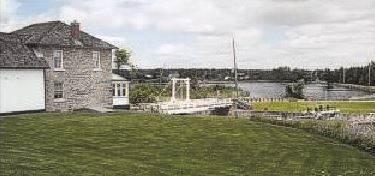
1424 Kilmarnock Road, Montague, Ontario
The Lockmasters
at Kilmarnock
The first lockmaster was James Maitland, a former soldier, recommended by Colonel John By. Maitland served until his retirement in 1846.
George Newsome, served 1846-1871.
Replaced by his son, William Newsome, the longest serving lockmaster on the Rideau, retired after 50 years, in 1921
J. R. Dalton, from 1922 to 1941
Fred Dawe, 1942 to 1945
R.V. Marshall from 1946 to 1964
Ted Moncrieff from 1965 to 1977
unknown from 1978 to 1980
Stan Irvin from 1980 to 1995
Ron Hyland served 1995 to 2000
Cemeteries of Montague
St. Bede’s Anglican Cemetery Nolan’s Corners, Montague Lot 19 Concession 5
McVean Cemetery Montague Lot 27 Concession 8
McCrae Family Cemetery Montague Lot 3 Concession 1
Christ Church Cemetery (also known as the Anglican Cemetery Lot 8 Concession 6, Status: Closed to further burials
Van Dusen Cemetery, Montague Township, Concession 1, Lot 24
St. John’s Anglican Cemetery, Montague Historical Municipality: Smith Falls Lot 30 Concession 5 North end of Mazie St.
St. Francis de Sales Roman Catholic Cemetery Montague Lot: 27 Concession: 7 Location Address: N of Kelly-Jordon Side Road on Hwy 15.
Montague Farm Museum

More than 30 years ago, Bill Dobson, established Montague Farm Museum, a private antique collection, a worthwhile destination for antique lovers and history buffs.
Some of the museum’s holdings: antique farming tools, implements, hand-made artifacts and textiles from the 1800 and 1900s, over 1,000 artifacts from the 1800s and 1900s, tools for blacksmithing, coopers, spinning, weaving, quilting and farming. Special treasures: An 1860s dowsing rod for locating water, and a horse-shaped pierced-tin trade sign from a horse-stable.
Montague Farm Museum is next door to a sheep cheese factory – Milkhouse Farm & Dairy and Lynda Hynes Pottery Studio, also beside the museum!
The museum is located at 1105 Matheson Rd., open by appointment only call 613-283-5270.
Bobolink Bird
The male has been described as a bird wearing a tuxedo, with his distinctive black and white coat. These birds are native to Montague Township, and many parts of Eastern Ontario. Bobolinks are small songbirds with somewhat flat heads, short necks, and short tails. They are related to blackbirds and orioles.
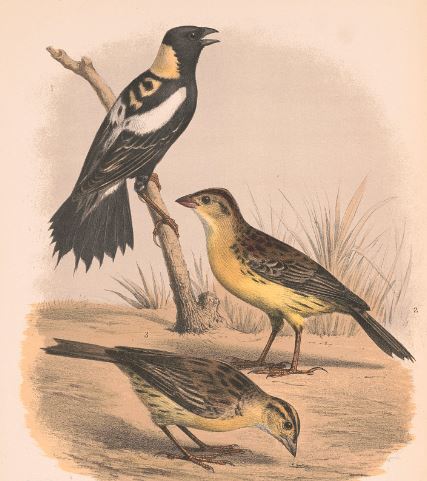
Native birds of Montague Township, Lanark County, Bobolinks nest in hay fields and livestock pastures.

Ramshead Lady Slipper
– native to Montague Township, member of the orchid family


Ramshead Lady Slipper – Orchid Family, rare, but still exist in many areas of Montague Township, and other parts of Eastern Ontario.
Familiar Names of Montague Township
Some familiar family names of Montague Township: McPherson, Jansen, Burrows, Kerfoot, Gulley, Houle, Shaw, Covill, MacDonald, Gilhuly, Patterson, Bates, Campbell, McVean, McCrea, Chester, Willoughby, Condie, Sheridan, Taylor, Griffith, Garland, Dopson, Phillips, Aldrich, Hill, Barton, Thomas, Lane, Merrick, Nettleton, Robinson, Phillips, Knapp, Vandusen, Crouch, Stafford, McIntyre, Burgess, Gilchrist, Rose, Sly, Wickware, Lake, Billings, Mars, Draper, Burchill, Chambers, Clark, Colborne, Cook, Davis, Empey, Ferguson, Fraser, Garrett, Hall, Jones, Livingstone, Poole, Newman, Shields, Stevens, Cameron.
Miscellaneous Articles
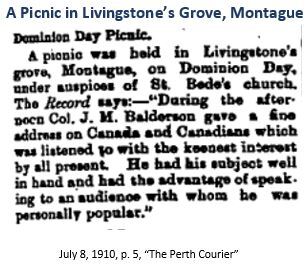

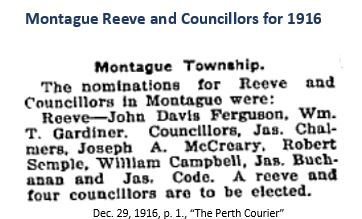

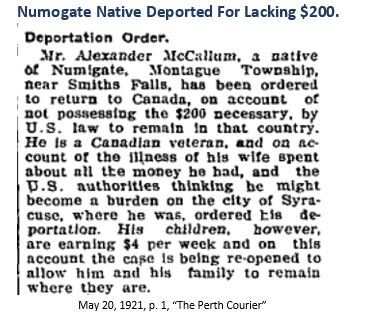
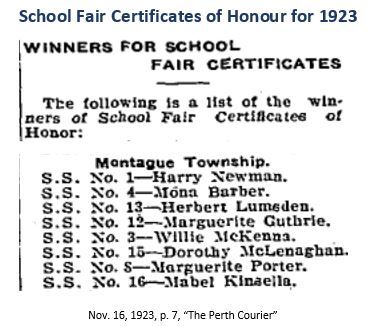
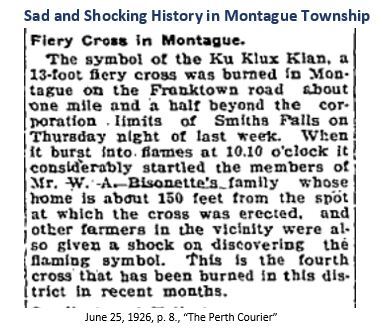

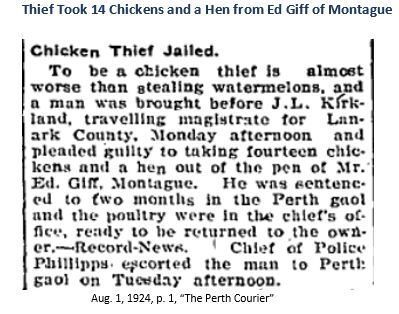
Visit Montague Township!
With a rich history including the proud United Empire Loyalists arriving in the 1790s, Montague Township is a wonderful place to live, to vacation, or a lovely place for a Sunday drive. With its charming communities of Numogate, Nolan’s Corners, Rosedale, and Kilmarnock, there’s something for everyone. Stop by one of the museums, or visit the grounds of one of the lovely historic churches. The local artisans, cheesemakers, and merchants will have the perfect souvenir of your day-trip. Don’t forget to visit the Kilmarnock locks and marvel at the engineering and beauty of the Rideau Canal, and the clear peaceful waters that remind us all of the special beauty of this part of Lanark County.

Arlene Stafford-Wilson
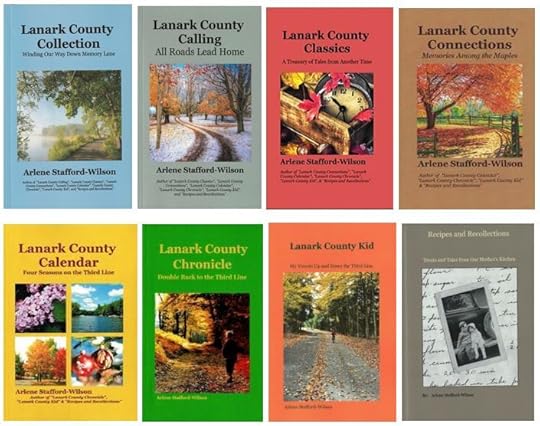
March 21, 2022
Spring Came Up the Third Line
One of my friends from DeWitt’s Corners said that they’d seen a robin in their back yard, but I hadn’t seen one yet. The only sign of spring that I’d noticed was the steady drip of water, coming off of the old roof, in the late afternoons, when I returned home from Glen Tay School. That meant that the temperature was rising above freezing during the day, so the sap must be running again.
Sure enough, that same day, I saw Dad heading down the lane, toward the Third Line, and he had his carpenter’s auger in his hands. That old thing looked battered and ancient, but it sure did the trick when he needed to tap some trees. We didn’t have a big maple bush like Korry’s, across the road, but Dad always tapped a few trees along the laneway, so that we’d have enough syrup for the family.
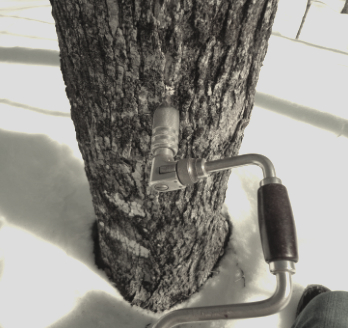
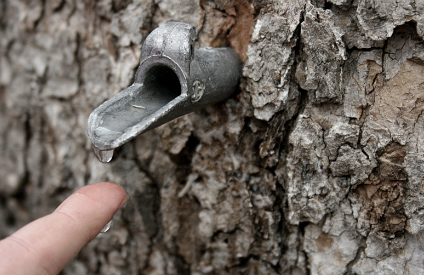
If anyone had bothered to stroll past the trees that we’d tapped, they likely would have laughed themselves silly. It wasn’t exactly a professional operation. None of the buckets matched. We had a grey metal pail, that hung on one of the spiles by a rusty wire. We also had a white plastic bucket, that Mother had made, by cutting up an empty corn syrup jug. Another bucket was made from an empty Billy Bee honey container. We even used one of my old sand pails, that I’d played with on the beach, when we went to Silver Lake in the summer. Any available container was ‘fair game’. It was only for a few weeks after all, and they couldn’t afford to be spending money on something that was used for such a short period of time each year.
Looking back, it didn’t really matter what kind of buckets you used, as long as you had something to collect the sap. I used to stand at the side of the tree, and watch as the clear, sweet liquid dripped ever so slowly, drip, drip, and splashed into the bucket below. I’d lift the bucket off of the metal hook, and dump the sap into Mother’s biggest mixing bowl, hook the bucket back on the tree, and carry the bowl gingerly up the lane way, and into the kitchen. Mother would be ready with a piece of clean cheesecloth, stretched over the big aluminum pot on the stove, and she’d take the bowl of sap, and dump it into the pot. The cheesecloth would catch all of the little specks of dirt, or bits of wood, that had come from the tree, so that the sap in the pot was nice and clean.
I guess if I’d been a little older, and a lot smarter, I would have asked Dad for one of the big pails from the garage, to transport all of the sap, in one trip, into the kitchen. Instead, I emptied one bucket at a time, into the big mixing bowl, and trekked all the way back and forth, up to the kitchen. Up the lane, and down the lane, I went over and over again, until I was finished; usually just before supper time. One night I forgot to empty the buckets, and the next night the sap was overflowing, running down the side of the tree, onto the snow. No one said anything about it, but I felt bad because I hadn’t done my job, and worse still we’d have less syrup because of it.
The air in the old kitchen smelled sweet for those few weeks each year, as the sap boiled away on top of the stove. Usually by the third or fourth day we’d have enough for a little bowl of syrup for dessert. The first syrup of the year was always the lightest in colour and in flavour, perfect for eating straight out of the bowl. Dad liked to pour a little cream into his syrup, and give it a stir. He’d take a piece of day-old homemade bread and dip it into his creamy syrup mixture, until he was down to the last sweet drops, and then he’d do one last sweep of the bowl with his bread.
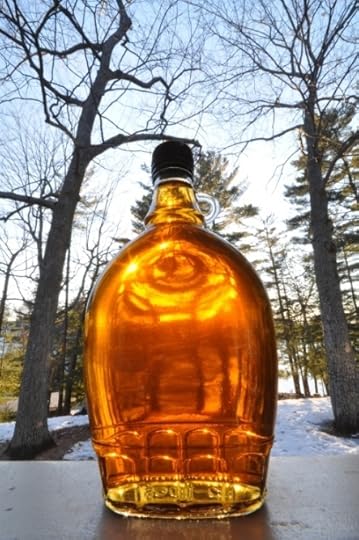
The other kids in the family poured their syrup over vanilla ice cream, but I liked mine straight-up, with nothing getting in between me and that sweet, perfect, maple flavour. I’d take a melamine bowl and teaspoon out of the old sideboard, pour myself a little, and enjoy it just like that.
As the weeks passed by, the syrup became darker in colour, and the flavour grew richer, and more intense. It was like magic watching the syrup change from a light honey colour to the rich, dark, amber toward the end of the run. The sap dripped slower and slower from the trees, as the days grew longer and warmer. When I waited for the big orange school bus to chug up the Third Line, it wasn’t as dark outside, nor as cold, in the early mornings,
The sun was shining a little brighter each week, and our driveway became a soggy obstacle course, as we stepped around the growing puddles of water. The snow banks finally shrunk, and shriveled away. Soon after, we’d take the buckets down, and put them away in the back porch for another year. Dad removed the spiles from the maple trees, wrapped them in a soft cloth, and placed them in the top drawer of his tool chest in the garage.
By then, the maple trees were beginning to bud, and a few of the familiar spring birds were returning to Mother’s bird feeder, in the back orchard. Almost all of the snow had shrunk down to a few dirty white mounds, spaced here and there in the yard, and the ground was spongy, cold and brown. The sun grew a little brighter each day, and stayed up in the sky later and later, after supper each night.
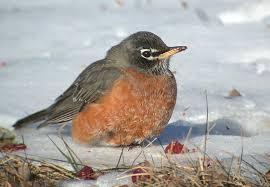
The warm weather wasn’t here yet, not even close; but all the signs were there that it was just around the corner. Each year when we tapped those maple trees, I knew that spring was not far away. It was only a matter of time now that she’d be coming up the Third Line, with all of her delicate shades of green. She’d be bringing her warm sun, and her gentle breezes. She’d slip into our yard quietly one morning, and tell all of the flowers to wake up, and show their colours. She’d whisper to the squirrels and the chipmunks, and invite them to come back and play in our yard.

I often wondered if spring could see us tapping our trees, and if that was her signal to make her way back into Lanark County, and into our yard. Maybe there was something magical about the syrup, and once we’d had our first taste, Old Man Winter knew that it was time for him to pack up his snow, and his cold winds, and head up north. Either way, we always knew that as soon as the sap began to run we’d be seeing spring in all of her glory in no time at all!

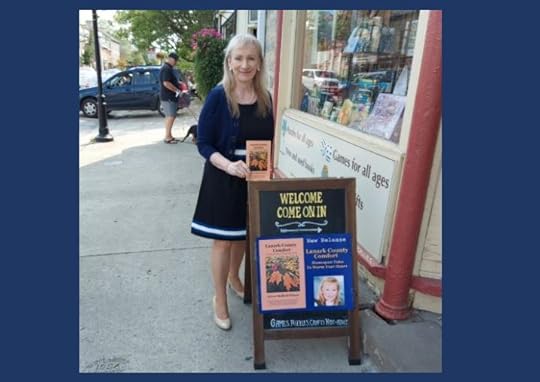
Arlene Stafford-Wilson
March 19, 2022
Pant Barn Dances
Rock and Roll and blue jeans were the iconic symbols of an unforgettable era, and of the youth of the 1970s. Loud rumbling muscle cars and long hair parted in the middle, set against a backdrop of pounding drum-beats and wailing guitars. Denim pants and blue-jean-jackets were the unofficial uniform at the Perth High School, and rock music – loud and heavy was the soundtrack of the times.
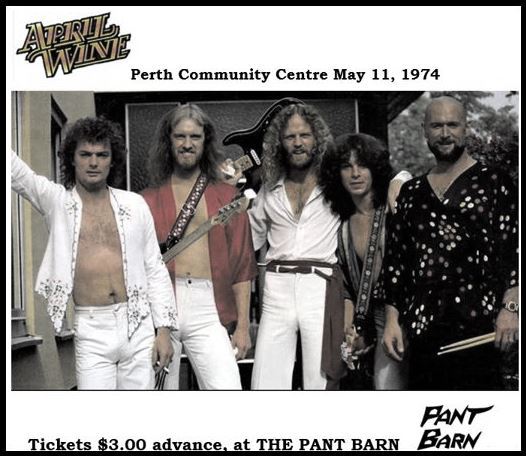
In a timely business decision, an enthusiastic 21-year-old kid from Smiths Falls, Perry Weagle, opened a blue-jean store called The Pant Barn, at 51 Foster St., in Perth, Ontario, in 1972. He also began to organize rock concerts. In the years that followed, he brought in some of the biggest rock and roll acts in Canada to play at the Farrell Hall, and later, the Community Center, in Perth.
His hugely popular store sold all of the latest styles in denim jeans, as well as the much-coveted tickets to his rock concerts, known as ‘Pant Barn Dances’.
The clothing store, and the concerts were enormously popular throughout the 1970s and 1980s, and teens were bused in from Almonte, Brockville, Carleton Place, Smiths Falls, to name a few.


Oct. 26, 1972, p. 6, “The Perth Courier”
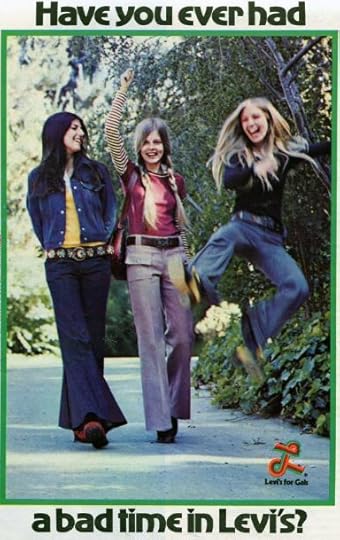 Levis Blue Jeans ad – 1972
Levis Blue Jeans ad – 1972
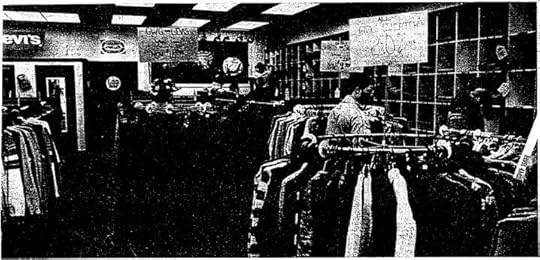
The Pant Barn, 51 Foster Street, Perth, Ontario
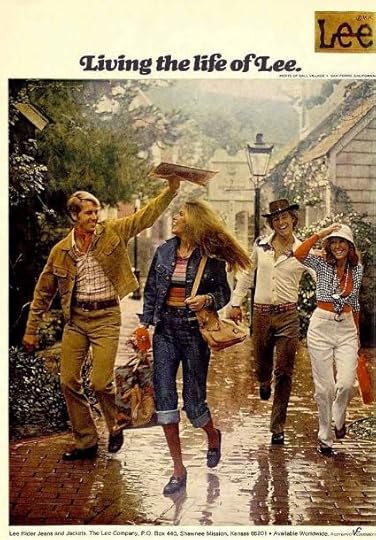 Lee Jeans ad, 1973
Lee Jeans ad, 1973

Aug. 24, 1972, “The Perth Courier”
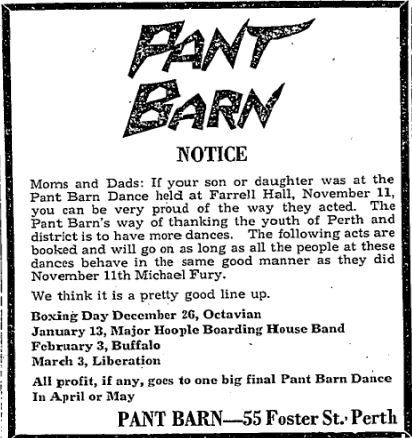
Nov. 2, 1972, p. 4 “The Perth Courier”
Popular Teen Dances
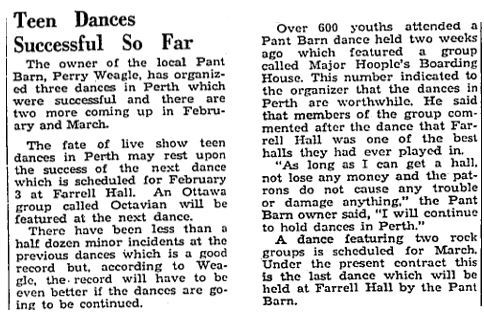
Jan. 25, 1973, p. 8 “The Perth Courier”

Octavian – 1973
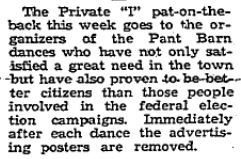
Apr. 5, 1973, p 9. “The Perth Courier”
Terry Dee & More Comes to Perth
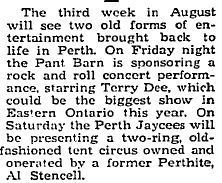
July 26, 1973, p. 9 “The Perth Courier”

Octavian and Larkspur
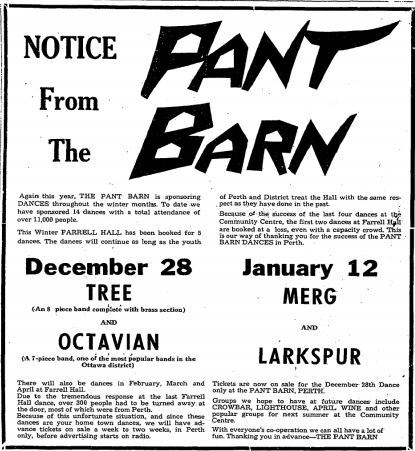
Dec. 13, 1973, p. 20, “The Perth Courier”
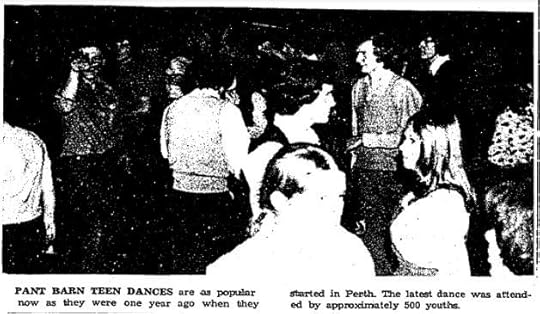
Feb. 21, 1974, p. 6 “The Perth Courier”

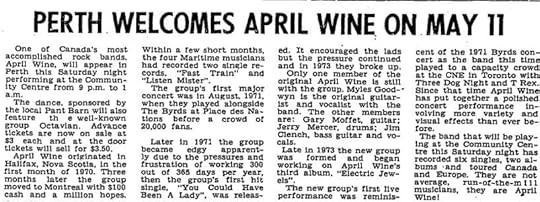
May 9, 1974, p. 7 “The Perth Courier”
2,000 Teens attend April Wine Concert
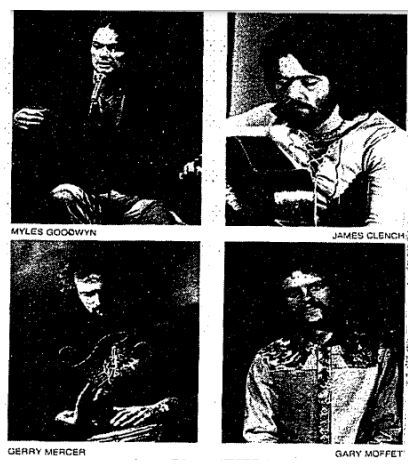
May 9, 1974, p. 7, “The Perth Courier”
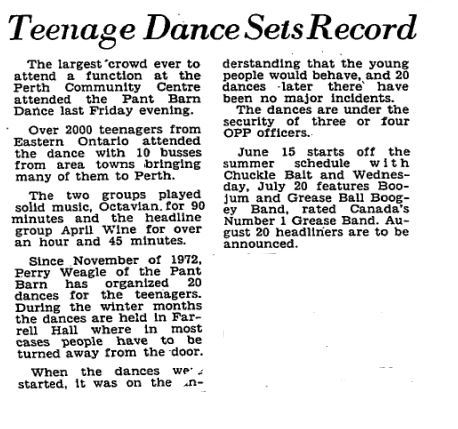
May 16, 1974, p. 6, “The Perth Courier”
“Youth Glad to Have Something to Do.”
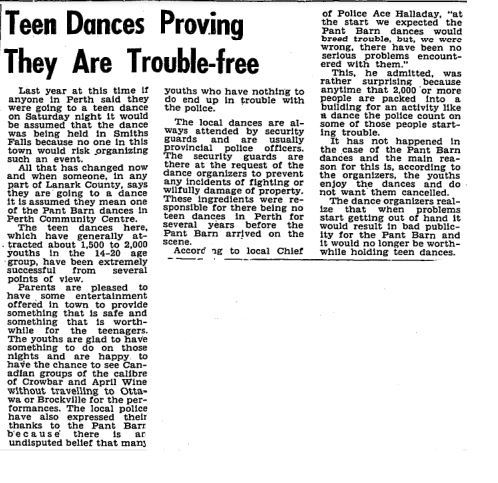
July 18, 1974, p. 19, “The Perth Courier”

Original members: Skip Prokop: drums and vocals, Paul Hoffert: keyboards and vibraphone, Ralph Cole: guitar and vocals, Grant Fullerton: bass and vocals, Vic “Pinky” Dauvin: percussion and lead vocals, Ian Guenther: violin, Don Dinovo: violin and viola, Don Whitton: cello, Leslie Schneider: cello, Freddy Stone: trumpet and flugelhorn, Arnie Chycoski: trumpet and flugelhorn, Howard Shore: alto saxophone, Russ Little: trombone
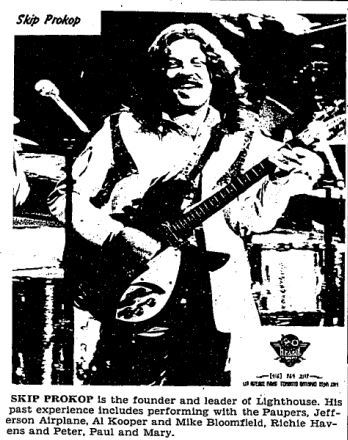
Aug. 8, 1974, p. 10, “The Perth Courier”
Canada’s Most Popular Band
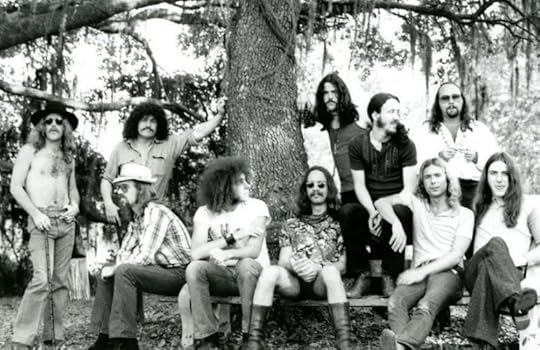 Lighthouse
Lighthouse
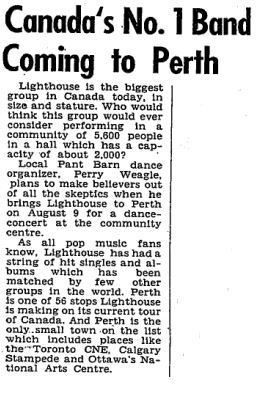
Aug. 8, 1974, p. 12 “The Perth Courier”

Aug. 15, 1974, p. 8, “The Perth Courier”

Oct. 3, 1974, p. 8, “The Perth Courier”

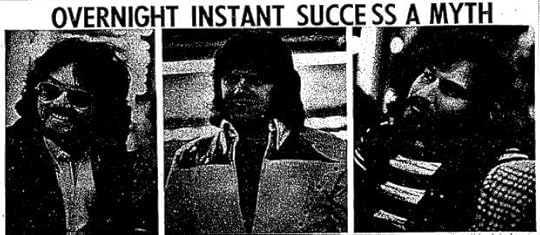
Oct. 10, 1974, p. 6 “The Perth Courier”
 The Stampeders
The StampedersThe Stampeder’s First Hit Single – “Carry Me”
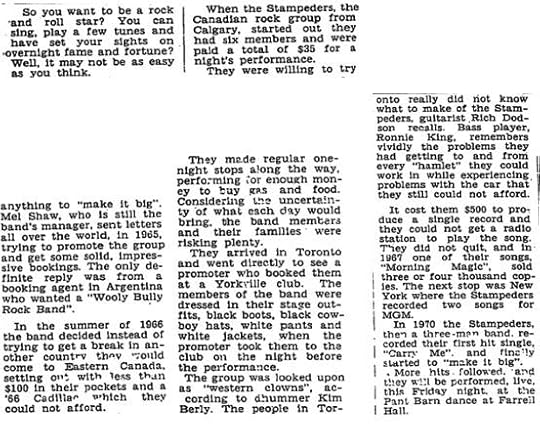
Oct. 10, 1974, p. 6, “The Perth Courier”

Nov. 7, 1974, p. 6, “The Perth Courier”
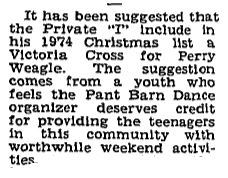
Nov. 21, 1974, p. 13, “The Perth Courier”
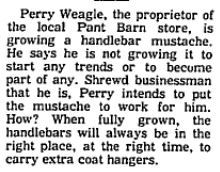
Mar. 27, 1975, p. 13, “The Perth Courier”
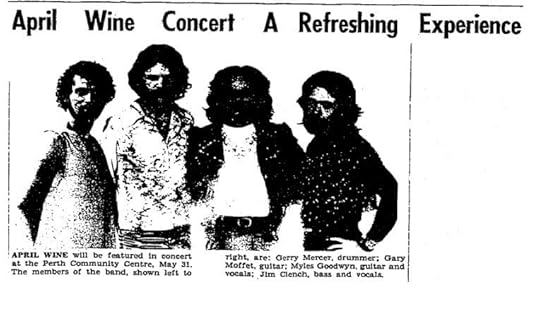
May 22, 1975, p. 16, “The Perth Courier”
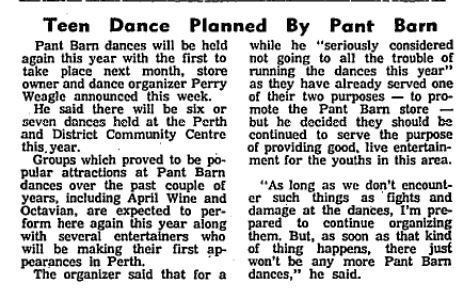
Apr. 22, 1976, p. 17, “The Perth Courier”
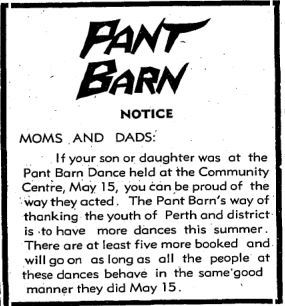
May 27, 1976, p. 18, “The Perth Courier”
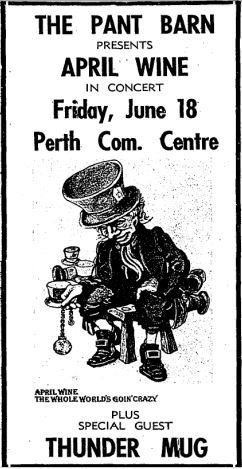
June 17, 1976, p. 7, “The Perth Courier”

‘A Foot in Coldwater’ – 50th Pant Barn Dance
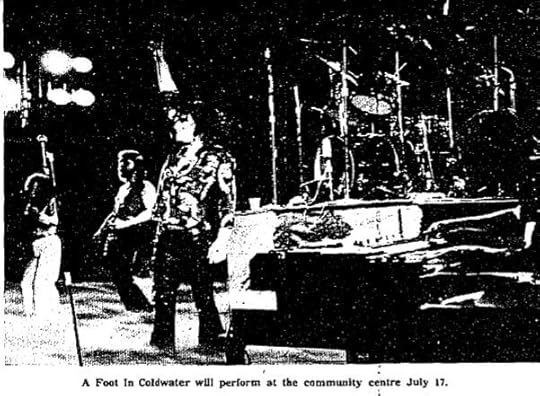
‘A Foot in Coldwater’ – the Pant Barn’s 50th rock concert – July 15, 1976, p. 9 “The Perth Courier”
‘A Foot in Coldwater’, article from “The Perth Courier”


July 15, 1976, p. 9, “The Perth Courier”
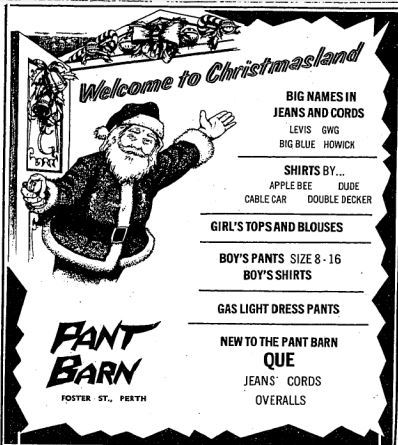
Dec. 9 1976, p. 10, “The Perth Courier”
55 Dances in Two Years
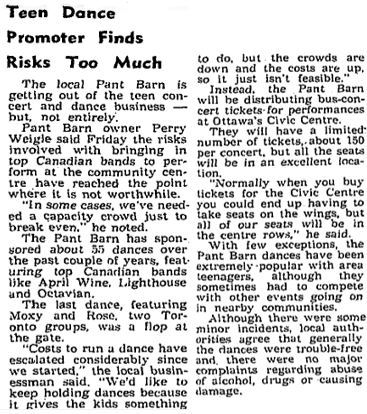
Pant Barn June 30 1977 p 15 “The Perth Courier”
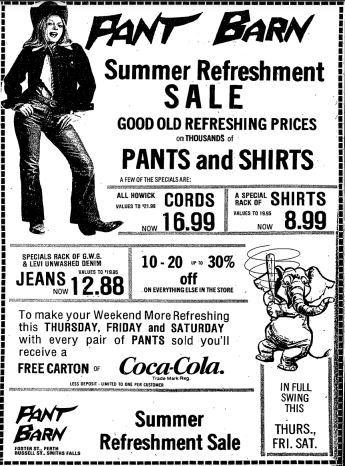
July 11, 1979, p. 16, “The Perth Courier”
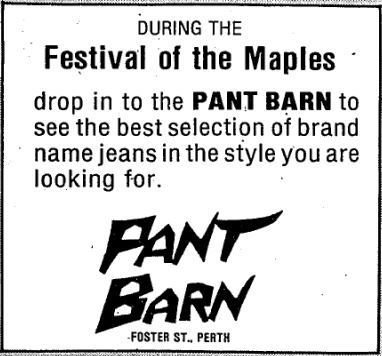
April 16, 1980, p. 17, “The Perth Courier”

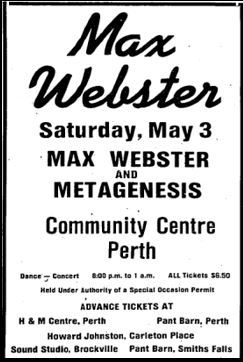
Apr. 23, 1980, p. 12, “The Perth Courier”
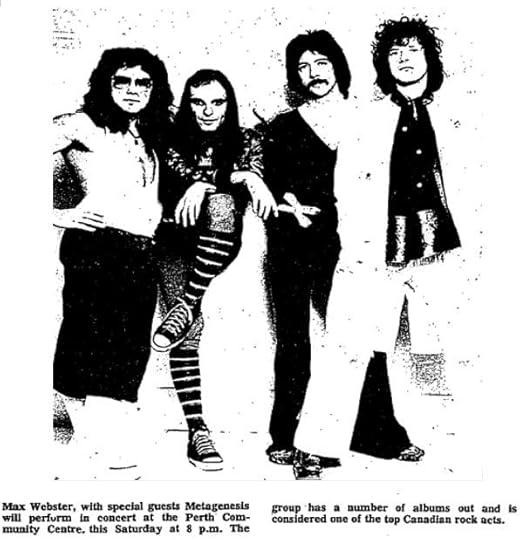
April 30, 1980, p. 13, “The Perth Courier”
 promotional photo – 1979
promotional photo – 1979Max Webster: Kim Mitchell – guitars and lead vocals, Terry Watkinson – keyboards and vocals, Mike Tilka – bass and vocals, Paul Kersey – drums and percussion, Pye Dubois – lyrics

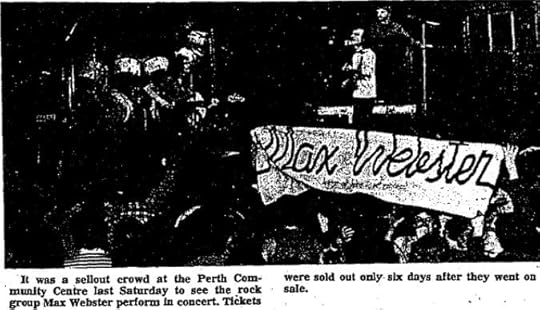
May 7, 1980, p. 31, “The Perth Courier”
Rowdy Crowd Gathers at Corner of Gore and Foster St.
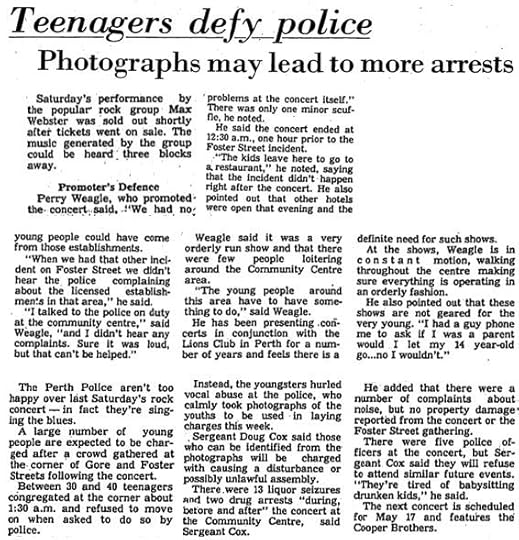
May 7, 1980, p. 1 “The Perth Courier”

Charges Laid Following 13 Liquor Seizures

May 7, 1980, p. 2 “The Perth Courier”

Discover the unforgettable concerts, the rock and roll, and go behind-the-scenes with the bands, all the special memories – With stories and anecdotes from Perry Weagle, and former staff of The Pant Barn and the Perth Community Center. The story that captures the memories – “The Legendary Pant Barn Dances”, part of a collection of short stories in new book, “Lanark County Comfort: Homespun Tales to Warm Your Heart”
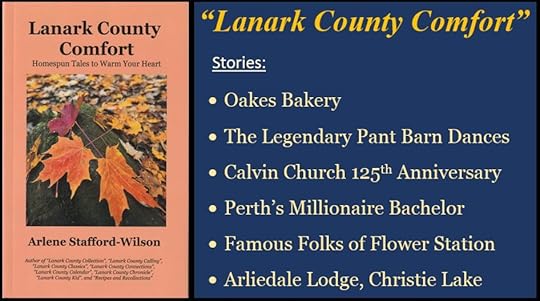
To purchase a copy, call – 613-267-2350, or online:
NEW RELEASE (preorder) – Lanark County Comfort; Home spun tails to warm your heart – Arlene Stafford-Wilson
Other books by: Arlene Stafford-Wilson


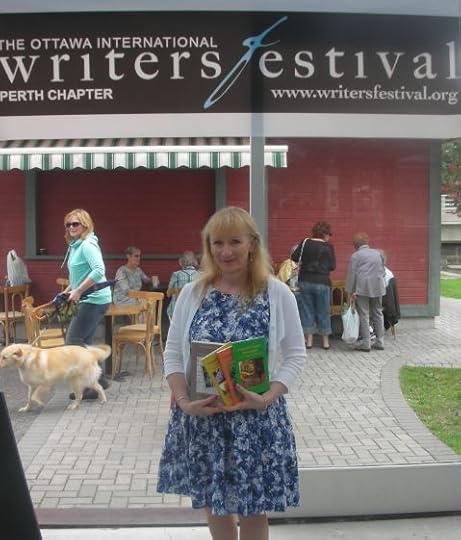
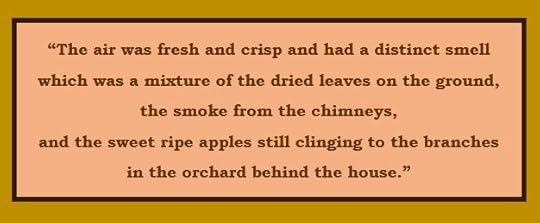

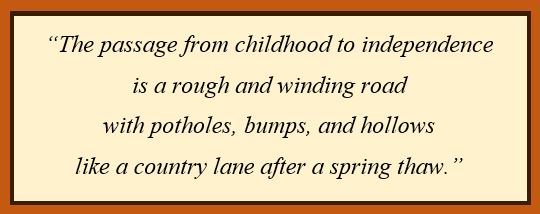
March 17, 2022
Irish Settlers & the Ghost of Burgess Township
The story of the Burgess Ghost begins with the arrival of so many Irish to the areas around Westport, the Scotch Line, Black Lake, and Stanleyville, that it became known as the ‘Irish Invasion’.
This is the the home where the story took place, in the cold, bitter winter of 1935, at the home of Mr. John Quinn. John lived in the house with his wife, and two sons Michael age 13, and Stanley, 11.

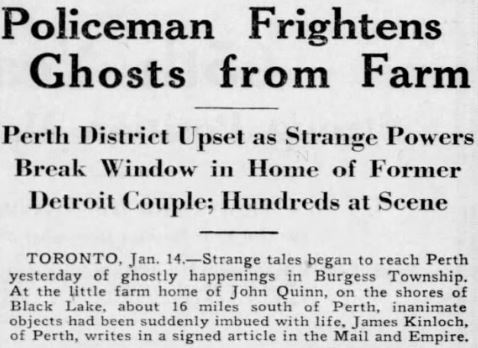
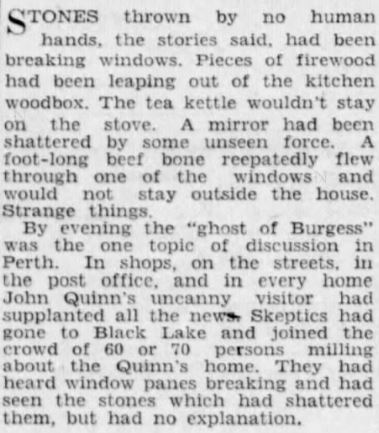



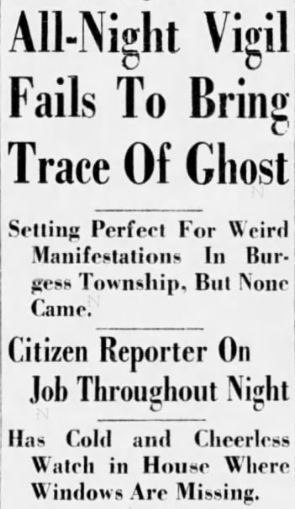
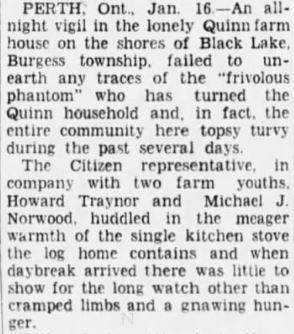
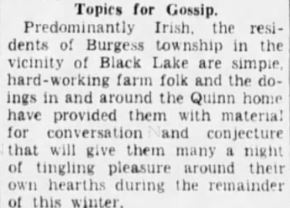
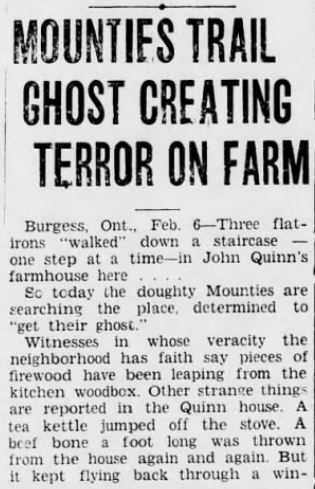
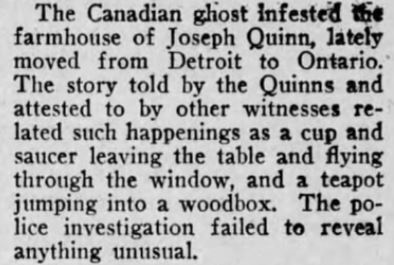
“Strange occurrences were happening in 1935 at a farm in North Burgess just off the Narrows Locks road. Mr. John Quinn, his wife and two children, Michael, and Stanley, ages 13 and 11, reported innumerable phenomena taking place in their home. Stove lids, according to the Quinns, “danced” in the air, the teapot “jumped” off the stove into the wood box, three flat irons “walked” down a staircase and dishes “pranced” on the dining-room table. Word of this mysterious goings on spread quickly throughout the district. Although, perhaps skeptical, hundreds of persons from miles around flocked to the Quinn home.
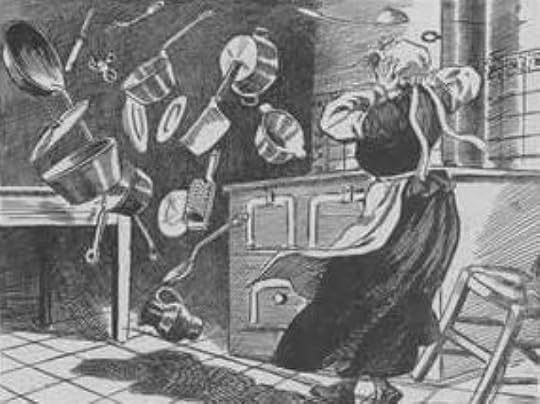
On the Sunday after the reporting of the “ghosts” more than 100 cars arrived at the Quinn farm. Along with the cars a flotilla of cutters and sleighs dotted the white-capped farm. The snow fell incessantly and the thermometer dipped way below the zero mark.
Newsmen from across the country arrived, and the CBC news from Toronto, reported the strange events. Although the strange occurrences could not be readily explained, many held doubts in their minds as the credulity of the phenomena. Believing that there had to be a reasonable explanation behind the occurrences, the Perth detachment of the OPP decided to hold an investigation.
On a Saturday afternoon, members of the force motored to the Quinn home, and inspected the building. Nothing strange occurred while they were there. That same evening Inspector Storey returned to the house. He remained there until Sunday morning along with about a dozen district men, sat in the house, speaking in hushed tones, but again nothing happened.

Mr. Quinn was unable to explain the strange occurrences that had been going on for the past couple of weeks. Pieces of beef he had placed in a barrel had been found littered throughout the house, he said, and the Wednesday before a window pane crashed for no apparent reason. He had not thought that too odd until it happened the very next evening.
Andrea Burke, a neighbouring farmer, declared that a bone thrown out of the home time and time again had always returned to the house for no explicable reason. Another neighbour, William Cordick, swore that he had seen three flat irons descend the Quinn’s staircase one after another.”
………………………………………………………………………………………………………………………………………..
Irish Settlers to North Burgess Township, Lanark CountyMost, but not all of the Irish in North Burgess Township, came from County Down and County Armagh, and many came in the 1840s, to escape a horrible famine, that swept through Ireland like an unstoppable plague. A disease called Potato Blight ravaged their crops for nearly a decade, and during that time over a million died of starvation, and an equal number fled Ireland on ships sailing to Canada and the United States.

Most were tenant farmers, leasing their land; unable to pay their rent when their crops failed, and were evicted by ruthless landlords. They bundled up what little they had, and boarded ships headed for the new world.
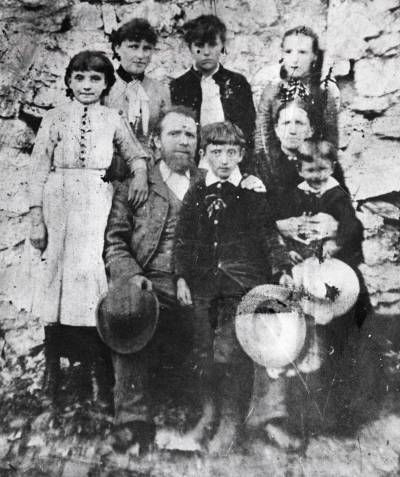
Seven weeks was the average length of time spent at sea, and the conditions endured by these Irish immigrants were so terrible that the ships were nick-named ‘coffin ships’. The lice, ticks and fleas common in these over-crowded vessels were the ideal breeding grounds for the transmission of disease, and by 1847 an average of 50 passengers died each day of typhus on their voyage from Ireland.
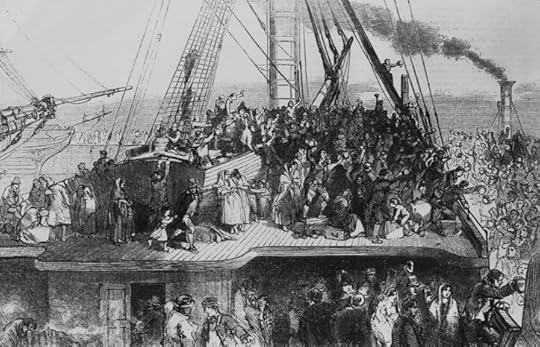
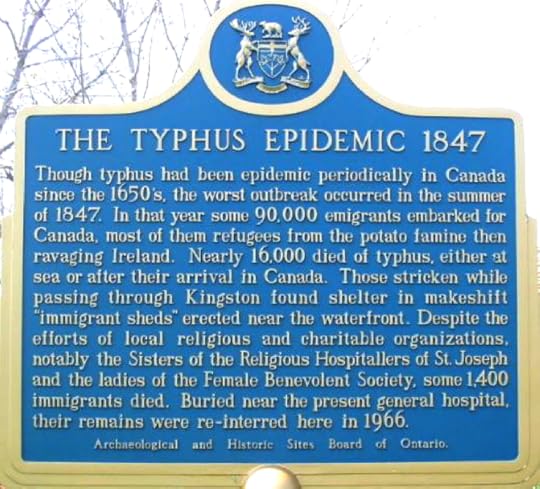

These new settlers brought their traditions, customs, and stories with them to the new country. Stories and legends were passed down from father to son, and from mother to daughter. Tales from the old country were told in the evenings by the fire, and the one story that seemed to run up and down the concessions in North Burgess was the legend of the Irish Banshee.

The Banshee, or ‘Bean Sidhe’ is an Irish spirit, and her high-pitched wail foretells of a death in the family. It was said that each family had its own Banshee, and that they travelled with them from the old country. Some said that the family’s Banshee would stay in Ireland at the family’s estate, and mourn the dead. The settlers to the new land brought their vivid descriptions of the Banshees – some claiming that she was an old hag with red eyes, but others said she was a fair, pale Irish beauty with long red hair dressed in a flowing gown.
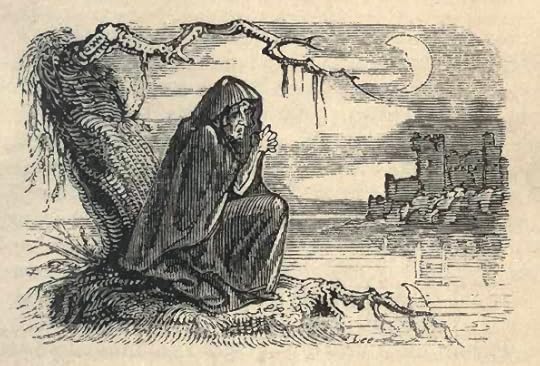

It’s been said that whoever hears her high and piercing shriek could be sure that there would be a death within 24 hours. Irish lore tells that the Banshee always wailed when a family member dies, even if the person had died far away, and news of their death had not yet come. The wailing of the banshee was the first warning to the household of the death.
When several banshees appeared at once, it was said to foretell of the death of someone prominent, or of an accidental or unintended death – often of a murder victim, a suicide, or a mother who died in childbirth.
The early settlers in North Burgess passed down their stories of banshees, fairies, ghosts and the little people. Although they were fiercely loyal to God and to the church, they never abandoned their beliefs in the spirits and creatures of their ancient folklore.
The Story of the Burgess Ghost became a local legend….The story of the ghost in the Quinn house was passed down through the years, told and retold at family gatherings, around campfires, and particularly in the weeks each year leading up to Hallowe’en.
In a strange final twist to the mystery of the Burgess Ghost, the Quinn family home burned to the ground. The cause of the fire was never determined, and remains a mystery to this day…..
In 1972, the Quinn home was burned to the ground.

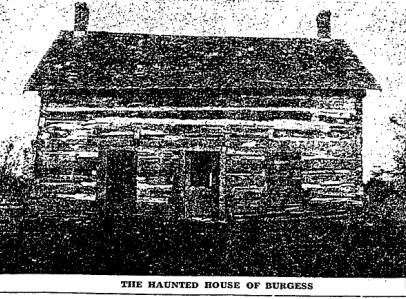
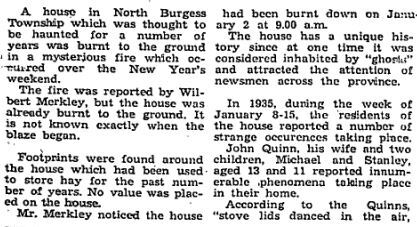
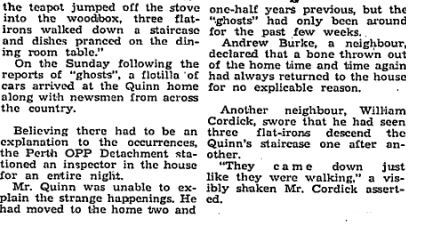
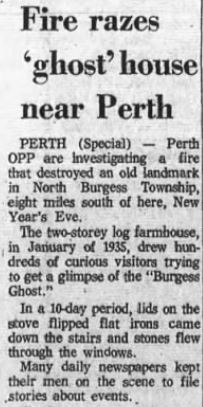
………
In 2002 the townships formerly known as North Burgess, South Sherbrooke and Bathurst were part of an amalgamation, and adopted the name of Tay Valley Township, as they are known today.
……..
For genealogical records of the founding families of North Burgess Township:
http://www.rootsweb.ancestry.com/~onlanark/nburgess.htm
National Archives of Canada – Immigration Databases Online Searh – Immigration to Canada
St. Bridget’s Cemetery Staneyville Ontario
Roman Catholic interments North Burgess Township
Scotch Line Cemetery – Burials from 1822-2000 North Burgess Township
Scotch Line Cemetery – North Burgess
Irish Immigration to Canada
Irish Immigration to Canada National Archives
Lanark County Genealogical Society
Archives Lanark
http://archiveslanark.ca/index.php
Search the census records for North Burgess Township, Lanark County
Searchable online census records for Lanark County
……………
For more information on Irish Folklore in the early days of Lanark County:
‘Banshees of Burgess’, is part of a collection of short stories in ‘Lanark County Classics – A Treasury of Tales from Another Time’. The reader will discover more about the early families from Ireland who settled in Lanark County, and their customs and beliefs in the supernatural, brought from the old country. The story explores some of the tales passed down by these Irish settlers, and documents their personal experiences with Banshees, ghosts, and fairies while living in Lanark County.
Available at The Book Nook, Spark Books & Curios, Mill St. Books and online.“Lanark County Classics” – ISBN 978-0-9877026-54
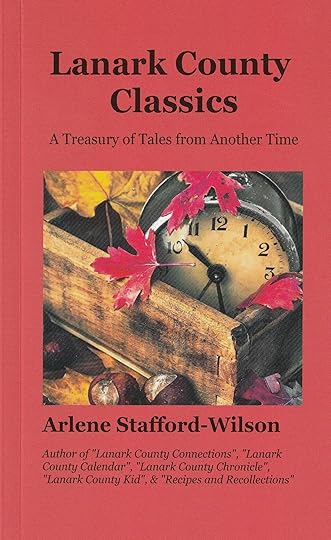
…..
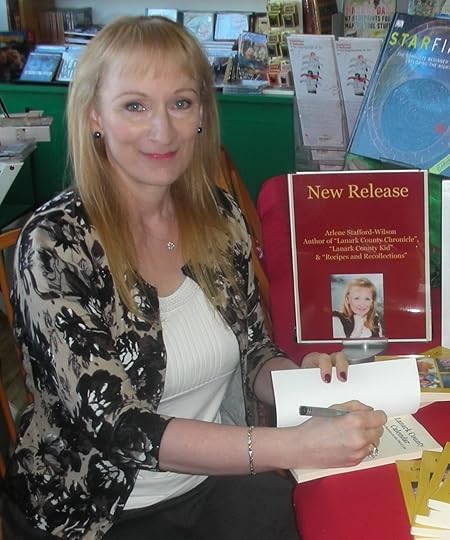
Arlene Stafford-Wilson
(map of Northern Ireland – By Maximilian Dörrbecker (Chumwa) – map by NNW, CC BY-SA 2.5, https://commons.wikimedia.org/w/index.php?curid=7918534)You May be Irish if…
1. You have the ‘gift of gab’. There is an ancient rock near Cork, Ireland at Blarney Castle and they say that anyone who kisses the stone will have the gift of gab. If you are truly of Irish descent, then there’s likely no pressing need to make the journey, as you surely already possess the talent of talking rings around most other people.
2. You are musical. Maybe you play an instrument or perhaps you just sing in the shower, but the gift of music is in your Irish blood and you will not be able to resist tapping your toe or strumming your fingers on the table when someone gets their fiddle out and plays a tune.
3. You have strong convictions. Whether the topic is religion, politics or your favourite sports team there will be no point in challenging your beliefs which you hold dearly, and you will argue about these beliefs passionately and convincingly.
4. You have a gift for writing and story-telling. You will be the one at the pub or social gathering that will keep the crowd entertained with your vivid and colourful tales. There may even be a bit of exaggeration thrown in for good measure, but it just makes your story all the more interesting.
5. You’ve got lovely skin and pleasing features. You may have porcelain, pale skin, or you may have freckles that outnumber the days of the year, but your features will be pleasantly proportioned and your eyes bright, with a genuine smile that lights up your face.
6. Your dinner is not complete without some spuds at the table. Whether it’s home-fries for breakfast, French fries for lunch, or baked, mashed or boiled for supper, the humble potato is a regular, healthy staple in your diet and you wouldn’t think of going a day without it.
7. You will likely have a few Irish names in your family tree because people of Irish descent are proud of their heritage and often pass down the names of their ancestors: Sean, Shane, Annie, Maggie, Michael, Patrick, Francis, Kelly, Bridget, Daniel, Aiden, Liam, Eileen, Irene, Brian, Barry, Collin, Ryan, Katie, Thomas, Matthew, Molly, William, Robert, Mark, Elizabeth, Peter, Sinead, Eva, Fay, Julia and so on…
8. You are better at swearing than most people. Partly because of your natural gift of gab and partly because of your quick wit, the swear-words seem to roll freely off of your tongue. You have even been known to make up your own, or stick a word in the middle for good measure, like “abso-bleedin’-lutely”.
9. Nothing brings out your poetic nature, natural ability to talk non-stop, or your talent for swearing like a few pints at the pub. A drink or two or three tends to make your exaggerations a bit more colourful, your storytelling even more fascinating, and your talent for music and dancing shines even brighter.
10. You are loyal. Your strong convictions and unshakable beliefs are the most visible when it comes to your family and friends. If someone insults your friend then they’ve likely got a fight on their hands that they won’t win. If someone says something unkind about your family then they will have a nasty surprise coming to them that they didn’t bargain for. You are fiercely loyal to all you hold dear.
So, what are the Irish really like? Perhaps the best description comes from the popular historian, Carl Wittke:
“The so-called Irish temperament is a mixture of flaming ego, hot temper, stubbornness, great personal charm and warmth, and a wit that shines through adversity. An irrepressible buoyancy, a vivacious spirit, a kindliness and tolerance for the common frailties of man and a feeling that ‘it is time enough to bid the devil good morning when you meet him’ are character traits which North Americans have associated with their Irish neighbors for more than a century.”
Whether you are of Irish descent or merely admire this nation known for its great writers, poets and story-tellers, I will leave you with a traditional Irish blessing and hope that you have the ‘luck o’ the Irish’ wherever life takes you! Sláinte (cheers!)
An Old Irish BlessingMay the road rise up to meet you.
May the wind always be at your back.
May the sun shine warm upon your face,
and rains fall soft upon your fields.
And until we meet again,
May God hold you in the palm of His hand.

Arlene Stafford-Wilson
(My ancestor, Tobias Stafford, left County Wexford, Ireland, in 1816, aboard the ship, Maria, and settled in Drummond Township, Lanark County. He married Elizabeth ‘Betsy’ McGarry, of Mullingar Parish, County Westmeath, Ireland at St. John’s Church, Perth, Ontario, on Feb. 10, 1824)
March 16, 2022
Irish Names & Surnames Explained
Traditional Irish Naming Patterns
Naming patterns are important when researching your family history. It has been a long standing custom in families around the world to name children after fathers, mothers, grandparents, important ancestors, relatives and friends. Middle names were often used for the preservation of a mother’s maiden name or the name of a prominent ancestor in that family. Names are very useful in tracking down lineages when there is little or no paper trail.
Names can give you clues to a person’s lineage, but other sources are still required in order to have genealogical proof. The Irish used a very particular naming pattern for children for children born beginning in the mid to late 1700s and through to the early to mid 1900s. It is important to note that not all Irish families followed the pattern although enough of them did that you can often use first names to learn more about an Irish ancestor’s unknown lineage. As with anything in genealogy, this should be proven with supporting documention, but Irish naming patterns are often helpful while building your family tree.
Traditional Irish Naming Pattern:
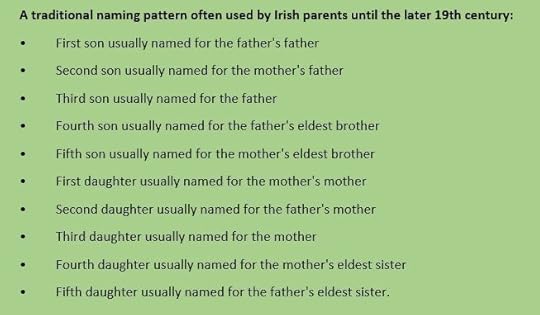
Naming Pattern Exceptions:
Naming patterns were sometimes affected by deaths in infancy. When a specific name was considered important within the family, the name would usually be given once again, to the next-born infant. In records, there are sometimes two or more children of the same name, baptized within the same family. Each baptism of this name, usually tells of the death of the older child of the same name.
Another example when the naming pattern is altered is when a child was stillborn, or very ill when born, or dying. Sadly, the child was baptized using a less-important family name, but the name of the paternal grandfather (or important ancestor) might be ‘reserved’ for a live birth, or for a child who was expected to live.
Surname Prefixes
Irish surnames of Gaelic origin were more common until Ireland fell under English rule. This led to the use of English versions of traditional Irish surnames. Many of these traditional names had prefixes:
“O”, “Fitz”, “Mc” and “Mac”
Mac or Mc – meaning “son of”
O – meaning “grandson of”
Fitz – meaning “son of” was sometimes substituted for the prefix ‘Mac’ or ‘Mc’ by many of the descendants of Anglo-Norman invaders.
For a period of time, English law in Ireland forbade the use of “O”, “Mc” and “Mac”, although “Fitz” was allowed. When researching your family name be aware that a name like Connor could have once been O’Connor.
The prefix O’ is unique to Ireland. It originates from the Gaelic word “ua,” meaning “grandson of.” Any name beginning with O’ is without question an Irish patronymic (from a male ancestor). The O’ surnames began in the 11th century in Ireland, before the Mc/Mac surnames. Examples of these surnames are O’Sullivan, O’Connor, O’Brien, and O’Leary.
Mc or Mac?
There is a myth about Scottish and Irish surnames that begin with the prefix Mac- or Mc-, that Mac- (as in MacDonald – son of Donald) designates a Scottish and Protestant heritage, where as Mc- (as in McCormick – son of Cormac) denotes an Irish Catholic family name. In fact there is no difference between these two prefixes. They may be either Irish or Scottish in origin and spelled different ways, with either prefix, even within the same family.
Mac- and Mc- both come from the Gaelic word “meic,” meaning “son of.”
“Micks”
In the early days of Irish settlement in Canada, such a large number of Irish names carried these prefixes that it became an ethnic slur for the Irish people to be called: “micks.”
Surnames that Describe the Profession of the Father
Some names beginning with Mc or Mac described the profession of the father.
MacMaster -“son of a master or religious leader”
Macpherson – “son of the parson,”
MacWard – “son of a poet or scribe,”
MacKenzie – “son of the fair one,”
MacDuff – “son of the dark one,”
McDowell – “son of the dark stranger.”.
Some families chose to conform to English laws, and some didn’t, which led to surname variations within the same family. Often Irish who emigrated dropped the prefixes when they arrived at their new countries of residence.
Top 200 Surnames in Ireland
Given Names and Meanings –
– BOYS
Given Names and Meanings
– GIRLS

Researching Your Irish Roots
Don’t forget Nicknames
Most given names in Ireland have at least one associated nickname. When names are recorded in birth, marriage, and death, or in church records, a nickname may have been used instead of the given name (Kate for Catherine or Billy for William, for example). Many nicknames are easy to spot, but others are less well known. For example, the nicknames used for Bridget include Bedelia, Bess, Bessie, Biddy, Breda, Briddy, Bride, or Bridie.
Nicknames may also lead the researcher astray if incorrect assumptions are used. While some might assume that Anty is a nickname for Anthony (a male), it is, in fact, more likely a nickname for Anastasia (a female). Lou is both a nickname for male children named Aloysius, Lewis/Louis, and Ulysses as well as female children names Louise or Lucinda or Mary-Louise, or Mary-Lou.
In conclusion, while naming patterns weren’t always followed exactly (for example if there were only one or two children, the father’s relatives always took precedence in the naming of the children), they were usually followed closely.
Remember, if you have an Irish ancestor, and don’t know anything of their parentage, you can use naming patterns to help in your search.
Best of luck researching your Irish ancestry!

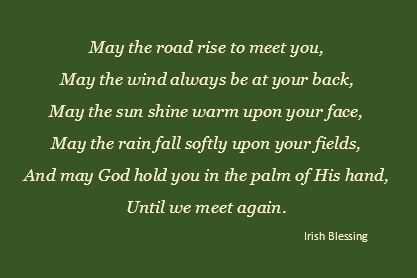
Sources:
De Breffny, Brian. Guide on Irish Christian Names and their English equivalents. Article Christian Names in Ireland found for years 1670-1850. The Irish Ancestor, Vol.1 No. 1, pages 34-40.Coghlan, Ronan. Irish First Names. Belfast, Ireland: Appletree Press, 1985.Ó Corráin, Donnchadh, and Fidelma Maguire. Irish Names. 2nd ed. 1990. Reprint. Dublin, Ireland: The Lilliput Press, 1992.MacLysaght, Edward. The Surnames of Ireland. 6th ed. Dublin, Ireland: Irish Academic Press, 1985.Matheson, Sir Robert E. Special Report on Surnames in Ireland [Together with] Varieties and Synonyms of Surnames and Christian Names in Ireland. 1901. Reprint. Baltimore, Maryland: Genealogical Publishing Co., 1968.You May be Irish if…
My Mother, she was Orange…..and my Father, he was Green
Irish Settlers & the Ghost of Burgess Township
Drummond Pioneer Irish Boxty
Irish Christmas in Lanark County
January 6th – Irish Women’s Little Christmas
Irish Hallowe’en in Lanark County
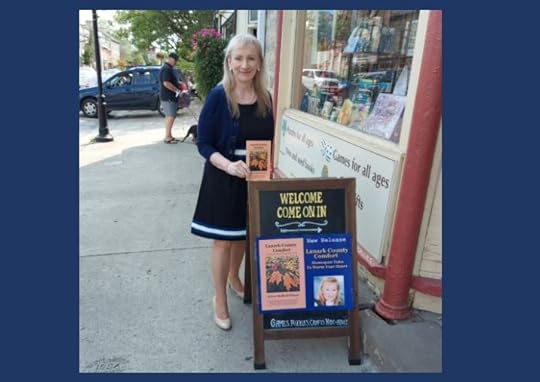
Arlene Stafford-Wilson
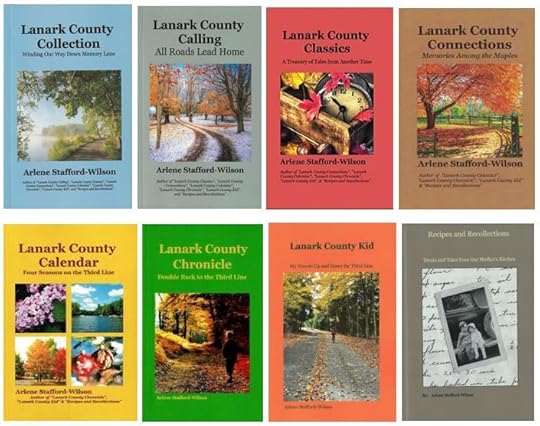
March 15, 2022
Tatlock Memories
Darling township, Lanark County, with localities including Tatlock, White, and Marble Bluff, was named in 1822 for a military officer, Major General H. C. Darling. He was a colonel serving as the military secretary to Canada’s Governor General. Darling Township was surveyed in 1822 for the influx of Scottish lowland settlers, as well as former soldiers disbanded after the War of 1812 who would be given land grants in this area. Tatlock, is located in what was known as the ‘rocky north’ of Darling Township.
Historic Darling Township Post Offices
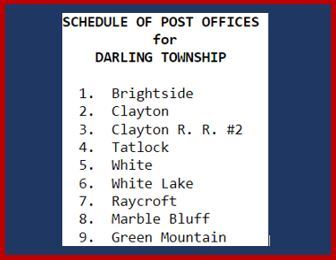
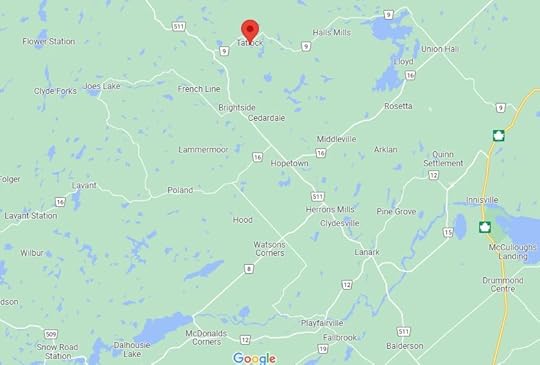
Google map – showing Tatlock and neighbouring communities
Tatlock Hall Opened – 1939
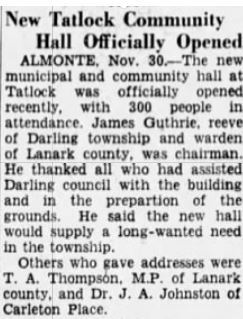
“The Ottawa Citizen”, Dec. 1, 1939, p. 7
The Tatlock Hall was built in 1850, originally a Presbyterian Church, near Brightside, on the French Line. By 1914 the church was closed.
In 1939 the building was torn down and rebuilt at Tatlock, to be used as a community hall. At the time, some believed that the cost to rebuild it, $300.00, would bankrupt Darling Township. Many years later, the hall was loaded onto a flatbed and moved again a short distance. Many upgrades and renovations have been added over the years, such as a new roof, insulation, a new kitchen, and decks off the washroom and kitchen.
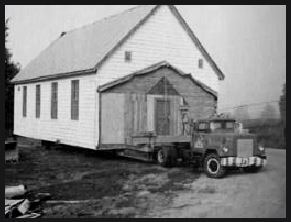

Tatlock Community Hall

Festival of Small Halls concert, at the Tatlock Hall, in 2017
Tatlock Marble Mine

Omega Marble Tile and Terazzo, opened in April 1963, in Tatlock, Darling Township, Lanark County. High quality marble, named “Rideau Blue”, “Rideau White”, and “Princess Blue” was in great demand, and was used on many distinguished buildings of that time.

Some of the members of the original 1963 Omega crew: Steve Bennett, Clydesville, Bert Wark, Tatlock, Bernard Nichols, Calabogie, Bob Neilson of Clydesville, and Ivan Wark, Tatlock.
Beaton Family
Remains Discovered
During excavations at the Omega mines in 1963, several old graves were unearthed, containing the remains of a pioneer family: John Beaton, one of the early teachers and farmers in the area, along with his wife, Janet (Paton), daughter, Helen, son, Thomas, and an unnamed child, who likely died at birth.
The grave marker indicated that the mother, Janet Beaton, was buried in 1903, at the age of 83, so the family were believed to be early settlers to the area. Bob Neilson of Clydesville levelled off the grave at the Omega mine, and the families remains were moved to the Hopetown Cemetery, where a gravestone was erected in their memory.

Families of Tatlock
Some of the early families of Tatlock: GUTHRIE, SCHAULER, CRAIG, FAY, RINTOUL, GUNN, WARK, CALDWELL, BARR, BUFFAM, MCILRAITH, MURRAY, CAMELON, MCDOUGALL, SMITH, FLEMING, SWEENEY, STEWART, BURNS, CRAWFORD, MAJAURY, BETELL, BEATON, RAYCROFT, PRETTY, TRAILL, JORDAN, LALONDE, LAROQUE, MAJORE, FOY, CARDINAL, RANGER, PERRY, MCFARLANE, BALLANTYNE, ELLIOTT, CAMELON, FRANK, VIRGIN, BRADFORD, LEE, PENMAN, KING, RABB, LANGSTAFF, WATT, BLACK, MUNRO, MCGEE, MCNEIL, LETT, PROCTOR, KILGORE, MCINTYRE, ROBERTSON, ABRAM, BOYLE, KINGSTON, SMITHSON, SPINKS, ROYCE, BARRIE, RING, MANARY, WHITE.

Arlene Stafford-Wilson


